
?wei_shuo的个人主页
?wei_shuo的学习社区
?Hello World !
Vue.js概述
Vue 是一套用于构建用户界面的渐进式JavaScript框架。 与其它大型框架不同的是,Vue 被设计为可以自底向上逐层应用。Vue 的核心库只关注视图层,不仅易于上手,还便于与第三方库或既有项目整合。另一方面,当与现代化的工具链以及各种支持类库结合使用时,Vue 也完全能够为复杂的单页应用(SPA)提供驱动
MVVM模型
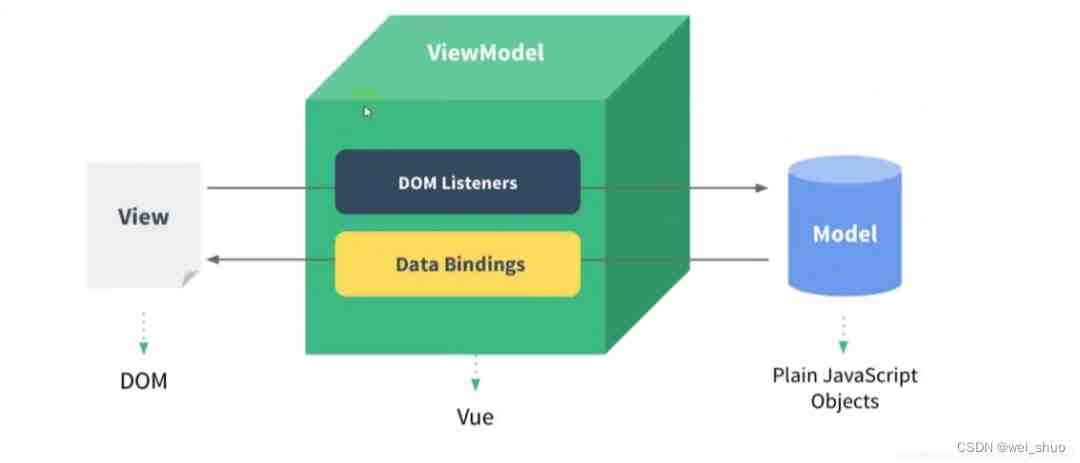
MVVM模型的特点:
低耦合:视图(View)可以独立Model变化和修改,一个ViewModel可以绑定到不同的View上,当View变化的时候Model可以不变,当Model变化的时候View也可以不变可复用:可以将视图逻辑放在ViewModel中,让更多View重用这段视图逻辑独立开发:开发人员可以专注于业务逻辑和数据开发(ViewModel),设计人员可以专注于页面设计可测试:测试可以针对ViewModel编写Hello Vue
<!doctype html><html lang="en"><head> <meta charset="UTF-8"> <meta name="viewport" content="width=device-width, user-scalable=no, initial-scale=1.0, maximum-scale=1.0, minimum-scale=1.0"> <meta http-equiv="X-UA-Compatible" content="ie=edge"> <title>Document</title> <script src="../sources/vue.js"></script></head><body><!--view层 模板--><div id="app"> <h1>{{message}}</h1></div><script> var vm = new Vue({ el: "#app", //绑定元素 //Model:数据 data:{ message:"Hello,Vue!" } });</script></body></html>缩写 v-bind & v-on
v-bind缩写<!-- 完整语法 --><a v-bind:href="url">...</a><!-- 缩写 --><a :href="url">...</a><!-- 动态参数的缩写 (2.6.0+) --><a :[key]="url"> ... </a><!-- 完整语法 --><a v-on:click="doSomething">...</a><!-- 缩写 --><a @click="doSomething">...</a><!-- 动态参数的缩写 (2.6.0+) --><a @[event]="doSomething"> ... </a>总结:
它们看起来可能与普通的 HTML 略有不同,但 : 与 @ 对于 attribute 名来说都是合法字符,在所有支持 Vue 的浏览器都能被正确地解析。而且,它们不会出现在最终渲染的标记中
Vue的7个属性
el属性指示vue编译器从什么地方开始解析 vue的语法
data属性组织从view中抽象出来的属性,可以说将视图的数据抽象出来存放在data中
methods属性放置页面中的业务逻辑,js方法一般都放置在methods中
template属性设置模板,会替换页面元素
computed属性用来计算,根据已经存在的属性计算出新的属性,对于同样的数据,会缓存
render属性创建真正的Virtual Dom
watch属性监听data中数据的变化
双向数据绑定
双向数据绑定,是指视图 View 的变化能实时地让数据模型 Model 发生变化,而数据的变化也能实时更新到视图层
输入框双向数据绑定<!--view层 模板--><div id="app"> 输入的文本:<input type="text" v-model="message">{{message}}</div><script> var vm = new Vue({ el: "#app", //绑定元素 //Model:数据 data:{ message:"同步更新" } });</script><!--view层 模板--><div id="app"> 性别: <input type="radio" name="sex" value="男" v-model="wei_shuo"> 男 <input type="radio" name="sex" value="女" v-model="wei_shuo"> 女 <p> 选中了谁:{{wei_shuo}} </p></div><script> var vm = new Vue({ el: "#app", //绑定元素 //Model:数据 data:{ wei_shuo:"" } });</script><!--view层 模板--><div id="app"> 下拉框: <select v-model="selected"> <option>---请选择---</option> <option value="A">A</option> <option value="B">B</option> <option value="C">C</option> <option value="D">D</option> </select></div><script> var vm = new Vue({ el: "#app", //绑定元素 //Model:数据 data:{ selected:"---请选择---" } });</script>组件
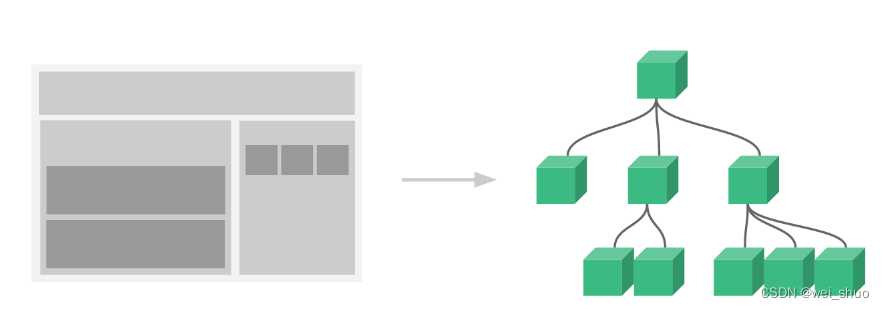
组件可以扩展 HTML 元素,封装可重用的代码;组件系统让我们可以用独立可复用的小组件来构建大型应用,几乎任意类型的应用的界面都可以抽象为一个组件树
格式:
Vue.component('my-component-name', { /* ... */ })该组件名就是 Vue.component 的第一个参数
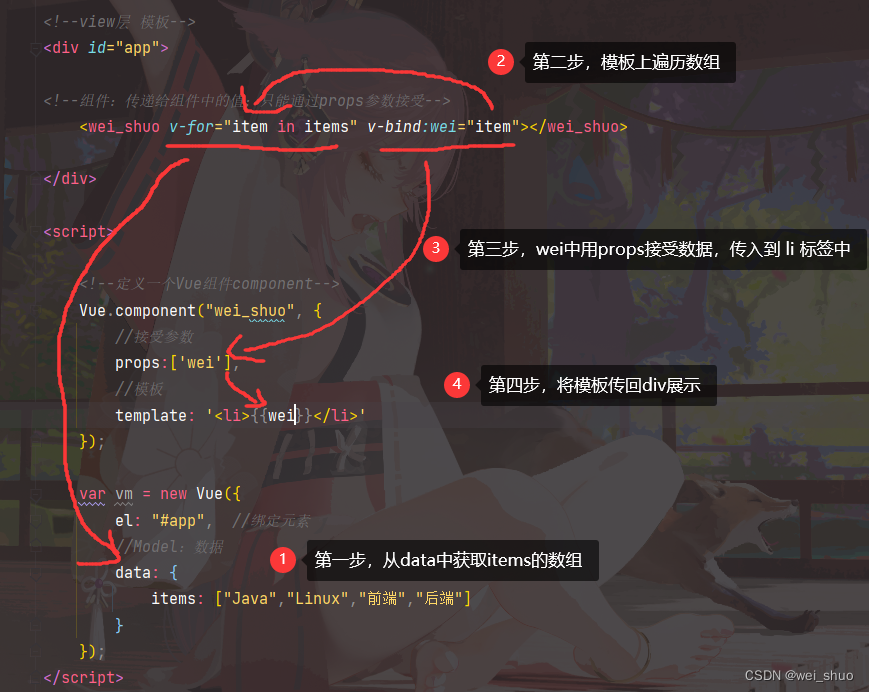
<!--view层 模板--><div id="app"><!--组件:传递给组件中的值;只能通过props参数接受--> <wei_shuo v-for="item in items" v-bind:wei="item"></wei_shuo></div><script> <!--定义一个Vue组件component--> Vue.component("wei_shuo", { //接受参数 props:['wei'], //模板 template: '<li>{{wei}}</li>' }); var vm = new Vue({ el: "#app", //绑定元素 //Model:数据 data: { items: ["Java","Linux","前端","后端"] } });</script>Axios异步通讯
Axios是一个开源的可以用在浏览器和NodeJS的异步通讯框架,主要作用是实现AJAX异步通讯
特点:
浏览器创建XMLHttpRequests从node.js创建http请求支持Promise API(JS中链式编程)拦截请求和响应转换请求数据和响应数据取消请求自动转换JSON数据客户端支持防御XSRF(跨站请求伪造)背景
Vue.js是一个视图层框架,作者(尤雨溪)严格准守SoC(关注度分离原则),所以Vue.js并不包含AJAX的通讯功能,为了解决通信问题,作者单独开发了名为vue-resource的插件,2.0版本以后停止了对该插件的维护并推荐了Axios框架
Vue声明周期
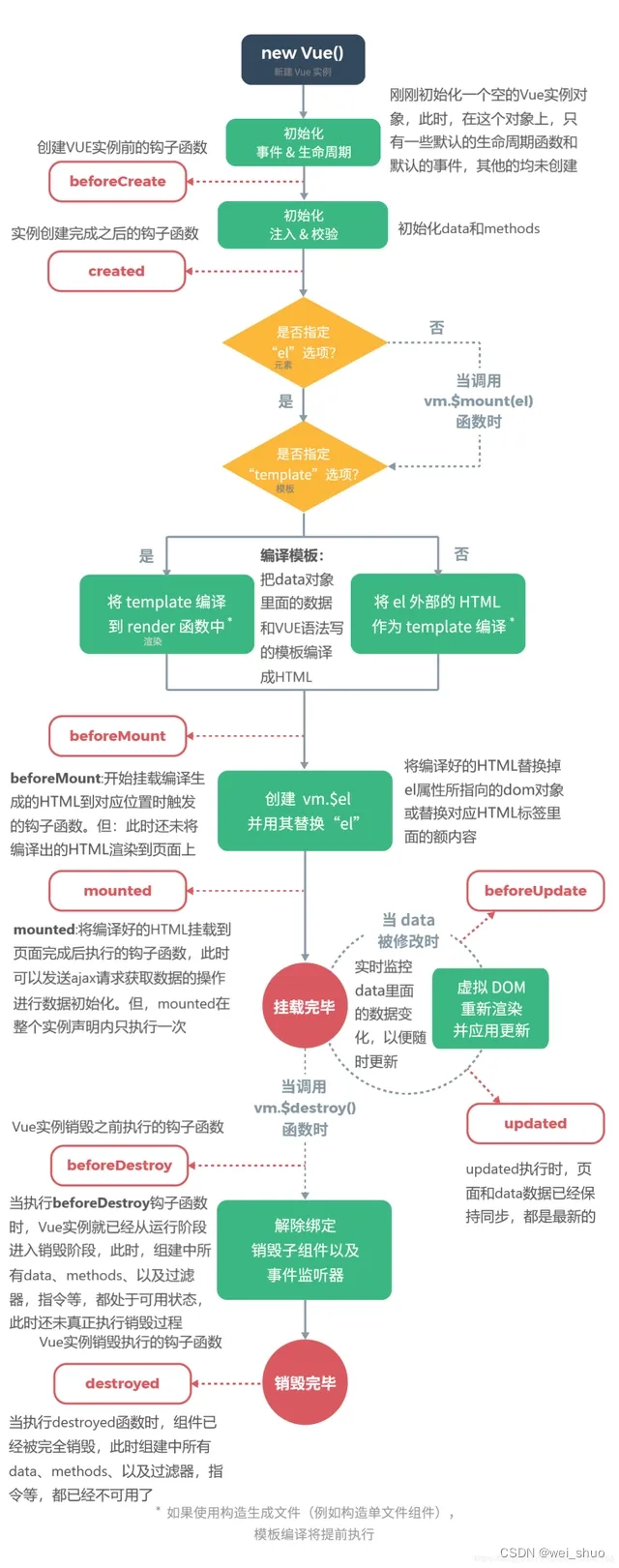
Vue实例有完整的声明周期,开始创建、编译模板、挂载DOM、渲染->更新->渲染、卸载等一系列操作,也就是Vue实例从创建到销毁的过程,称为Vue的声明周期
声明周期钩子函数
创建前(beforeCreate)Vue实例开始初始化时调用
创建后(created)实例创建之后进行调用,此时尚未开始DOM编译
载入前(beforeMount)依然得不到具体的DOM元素,但vue挂载的根节点已经创建
载入后(mounted)在DOM文档渲染完毕之后进行调用
更新前(beforeUpdate)data更新时触发
更新后(updated)data更新时触发
销毁前(beforeDestroy)销毁实例前进行调用,此时实例任然有效
销毁后(destroyed)实例被销毁之后进行调用
创建data.json文件{ "name": "wei_shuo", "url": "http://baidu.com", "page": "1", "isNonProfit": "true", "address": { "street": "陕西", "city": "西安", "country": "中国" }, "links": [ { "name": "B站", "url": "https://www.bilibili.com/" }, { "name": "4399", "url": "https://www.4399.com/" }, { "name": "百度", "url": "https://www.baidu.com/" } ]}<script src="../sources/vue.js"></script><script src="https://unpkg.com/axios/dist/axios.min.js"></script><!doctype html><html lang="en"><head> <meta charset="UTF-8"> <meta name="viewport" content="width=device-width, user-scalable=no, initial-scale=1.0, maximum-scale=1.0, minimum-scale=1.0"> <meta http-equiv="X-UA-Compatible" content="ie=edge"> <title>Document</title> <script src="../sources/vue.js"></script> <script src="https://unpkg.com/axios/dist/axios.min.js"></script> <!-- v-cloak 解决闪烁问题 --> <style> [v-clock]{ display: none; } </style></head><body><div id="app" v-clock> <div>{{info.name}}</div> <div>{{info.address.street}}</div> <a v-bind:href="info.url">点击</a></div><script> var vm = new Vue({ el: "#app", data() { return { //请求的返回参数,必须和json字符串一致 info:{ name:null, address:{ street:null, city:null, contry:null }, url:null } } }, mounted() { //钩子函数 链式编程 axios.get('../data.json').then(response => (this.info = response.data)); } })</script></body></html>/*浏览器显示结果:wei_shuo陕西点击*/内容分发(Slot插槽)
Vue.js中使用元素作为承载分发内容的出口,作者称为插槽,可以应用在组合组件的场景中
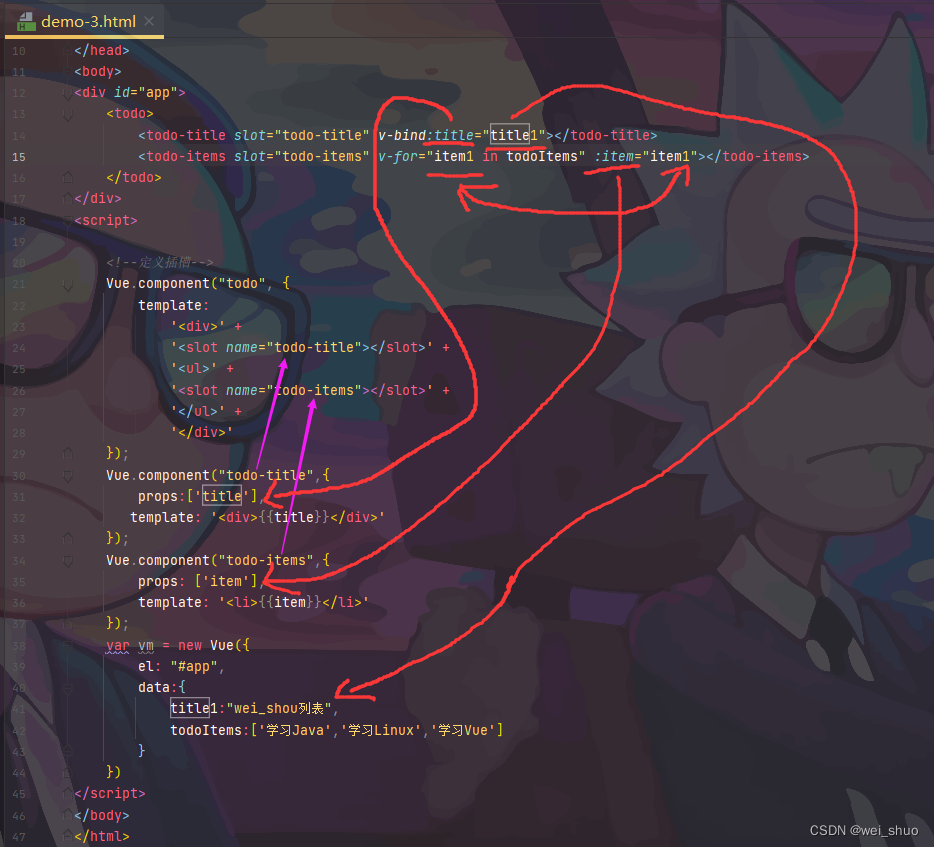
<!doctype html><html lang="en"><head> <meta charset="UTF-8"> <meta name="viewport" content="width=device-width, user-scalable=no, initial-scale=1.0, maximum-scale=1.0, minimum-scale=1.0"> <meta http-equiv="X-UA-Compatible" content="ie=edge"> <title>Document</title> <script src="../sources/vue.js"></script></head><body><div id="app"> <todo> <todo-title slot="todo-title" v-bind:title="title1"></todo-title> <todo-items slot="todo-items" v-for="item1 in todoItems" :item="item1"></todo-items> </todo></div><script> <!--定义插槽--> Vue.component("todo", { template: '<div>' + '<slot name="todo-title"></slot>' + '<ul>' + '<slot name="todo-items"></slot>' + '</ul>' + '</div>' }); Vue.component("todo-title",{ props:['title'], template: '<div>{{title}}</div>' }); Vue.component("todo-items",{ props: ['item'], template: '<li>{{item}}</li>' }); var vm = new Vue({ el: "#app", data:{ title1:"wei_shou列表", todoItems:['学习Java','学习Linux','学习Vue'] } })</script></body></html>自定义事件($emit)
自定义事件分发
格式: this.$emit('自定义事件名',参数)this.$emit('remove', index);<!doctype html><html lang="en"><head> <meta charset="UTF-8"> <meta name="viewport" content="width=device-width, user-scalable=no, initial-scale=1.0, maximum-scale=1.0, minimum-scale=1.0"> <meta http-equiv="X-UA-Compatible" content="ie=edge"> <title>Document</title> <script src="../sources/vue.js"></script></head><body><div id="app"> <todo> <todo-title slot="todo-title" v-bind:title="title1"></todo-title> <todo-items slot="todo-items" v-for="(item1,index) in todoItems" :item="item1" v-bind:index="index" v-on:remove="removeItems(index)" v-bind:key="index"></todo-items> </todo></div><script> <!--定义插槽--> Vue.component("todo", { template: '<div>' + '<slot name="todo-title"></slot>' + '<ul>' + '<slot name="todo-items"></slot>' + '</ul>' + '</div>' }); Vue.component("todo-title", { props: ['title'], template: '<div>{{title}}</div>' }); Vue.component("todo-items", { props: ['item', 'index'], //只能绑定当前组件的方法 template: '<li>{{index}}---{{item}}<button @click="remove">删除</button></li>', methods: { remove: function (index) { //自定义事件分发 //this.$emit('自定义事件名',参数) this.$emit('remove', index) } } }); var vm = new Vue({ el: "#app", data: { title1: "wei_shou列表", todoItems: ['学习Java', '学习Linux', '学习Vue'], removeItems: function (index) { console.log("删除" + this.todoItems[index] + "OK") this.todoItems.splice(index, 1); //一次删除一个元素 } } })</script></body></html>vue-cli项目
vue-cli是官方提供的一个脚手架,用于快速生成一个vue的项目模板;预先定义的目录结构及基础代码,使开发更加快速
功能:
统一项目结构本地调试热部署单元测试集成打包上线 创建Vue项目,新建目录cmd目录窗进入创建的目录路径运行vue init webpack myvue命令初始化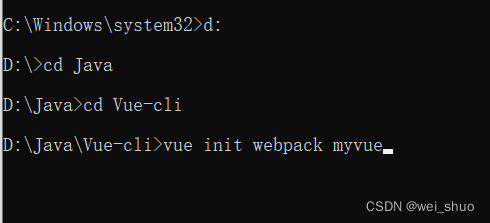
等待5分钟左右,即可初始化完成
项目名称
? Project name (myvue)
项目描述
? Project description (A Vue.js project)
作者
? Author
构建(选择第一个即可:运行时编译)
? Vue build (Use arrow keys)
vue路由,以下n即是手动创建,y即是自动创建
? Install vue-router? (Y/n)
? Use ESLint to lint your code?(Y/n)
? Set up unit tests (Y/n)
? Setup e2e tests with Nightwatch? (Y/n)
No即不会自动npm install,yes就会自动npm install
? Should we run npm install for you after the project has been created? (recommended) (Use arrow keys)
Yes, use NPM
Yes, use Yarn
No, I will handle that myself
D:\Java\Vue-cli>vue init webpack myvue? Project name (myvue)? Project description (A Vue.js project)? Author ? Vue build (Use arrow keys)> Runtime + Compiler: recommended for most users Runtime-only: about 6KB lighter min+gzip, but templates (or any Vue-specific HTML) are ONLY allowed in .vue files - render functions are required elsewhere? Install vue-router? No? Use ESLint to lint your code? No? Set up unit tests No? Setup e2e tests with Nightwatch? No? Should we run `npm install` for you after the project has been created? (recommended) (Use arrow keys)> Yes, use NPM Yes, use Yarn No, I will handle that myself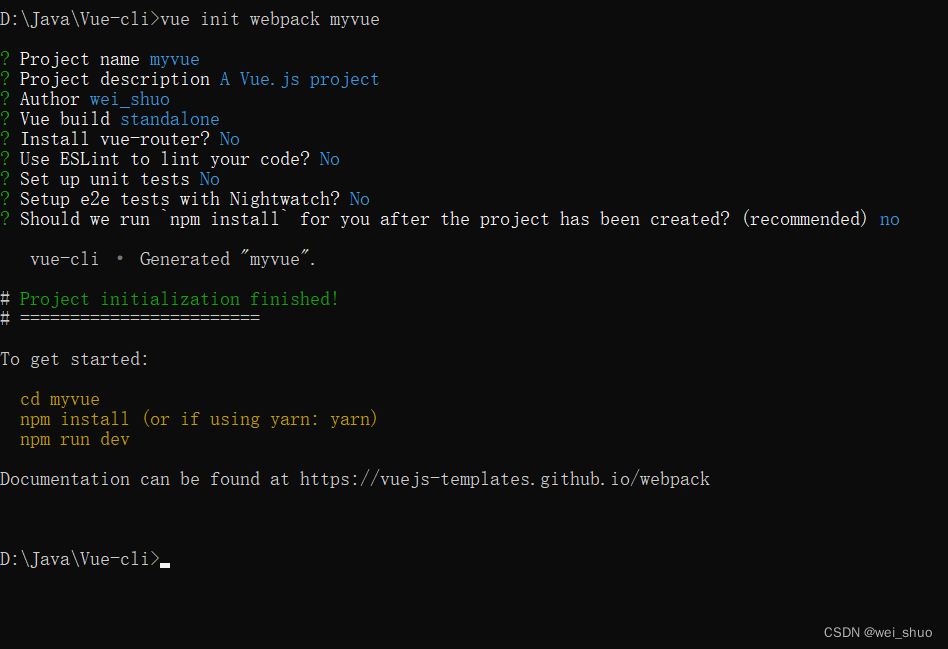
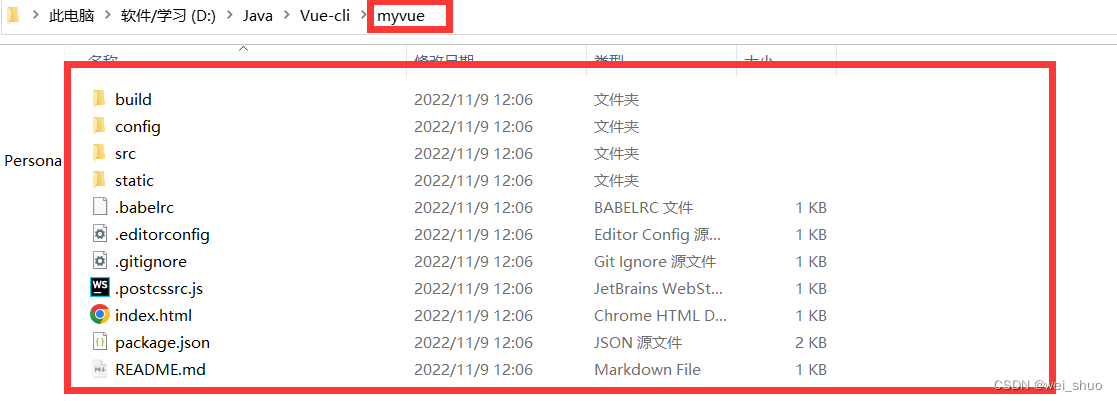
初始化运行
cd myvue
npm install
npm run dev
cmd窗口进入myvue路径
执行npm install命令
如果中途报错,安装命令窗口提示执行提示命令即可修复
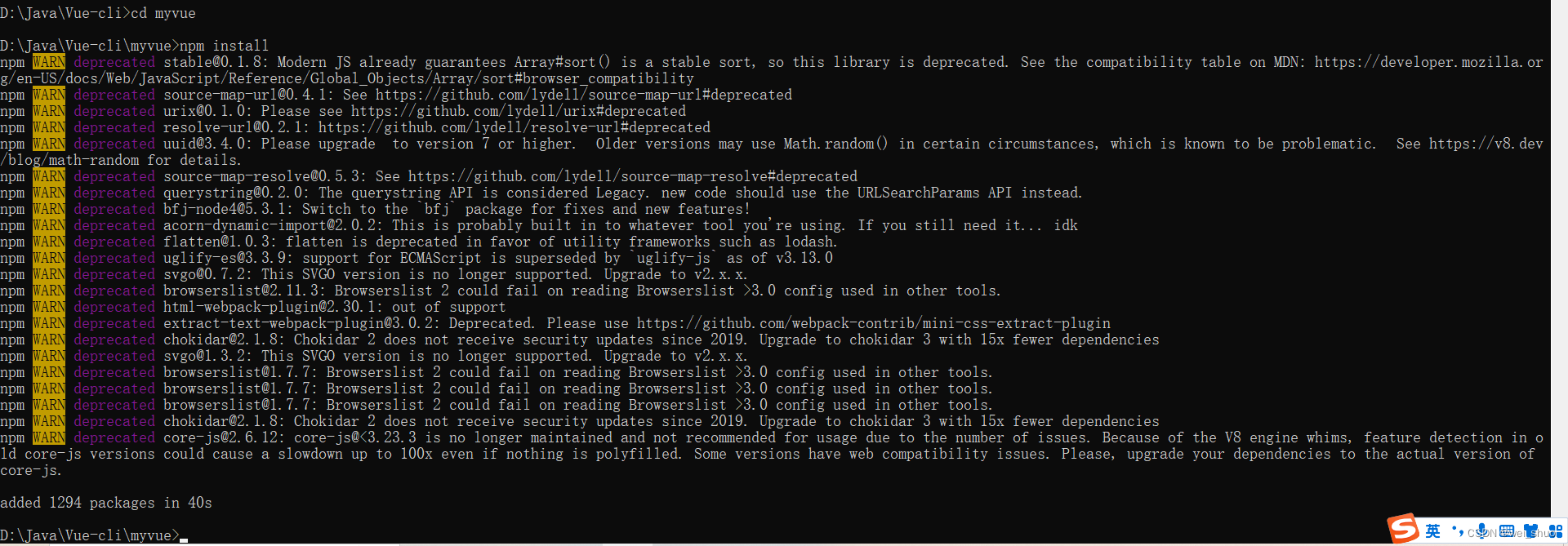
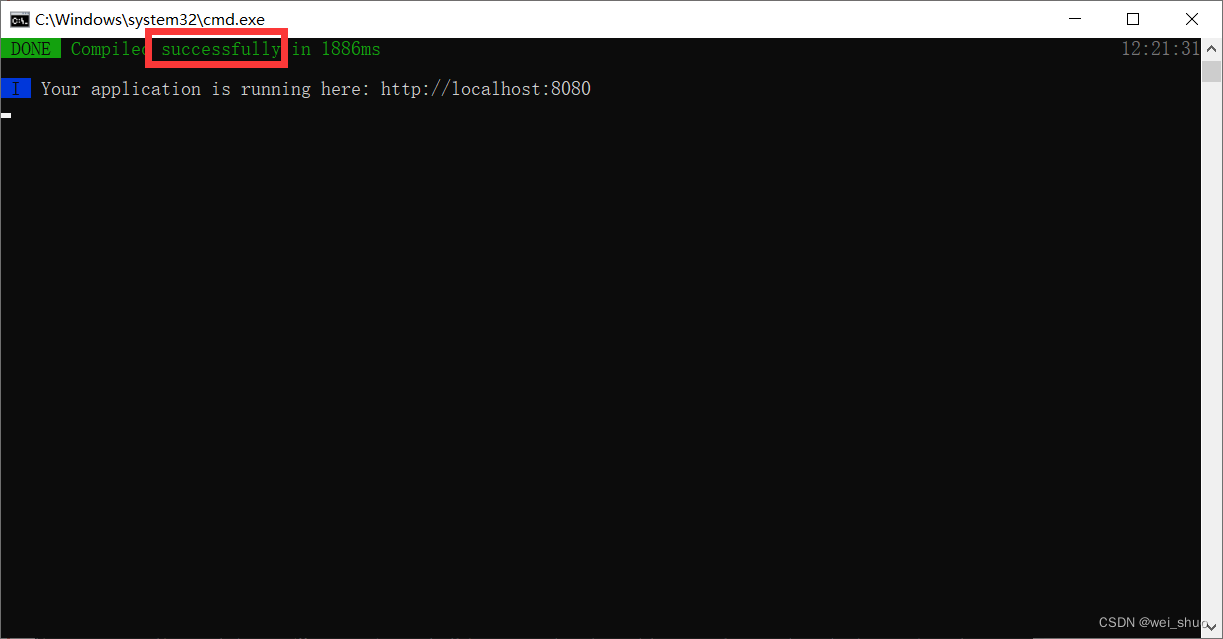
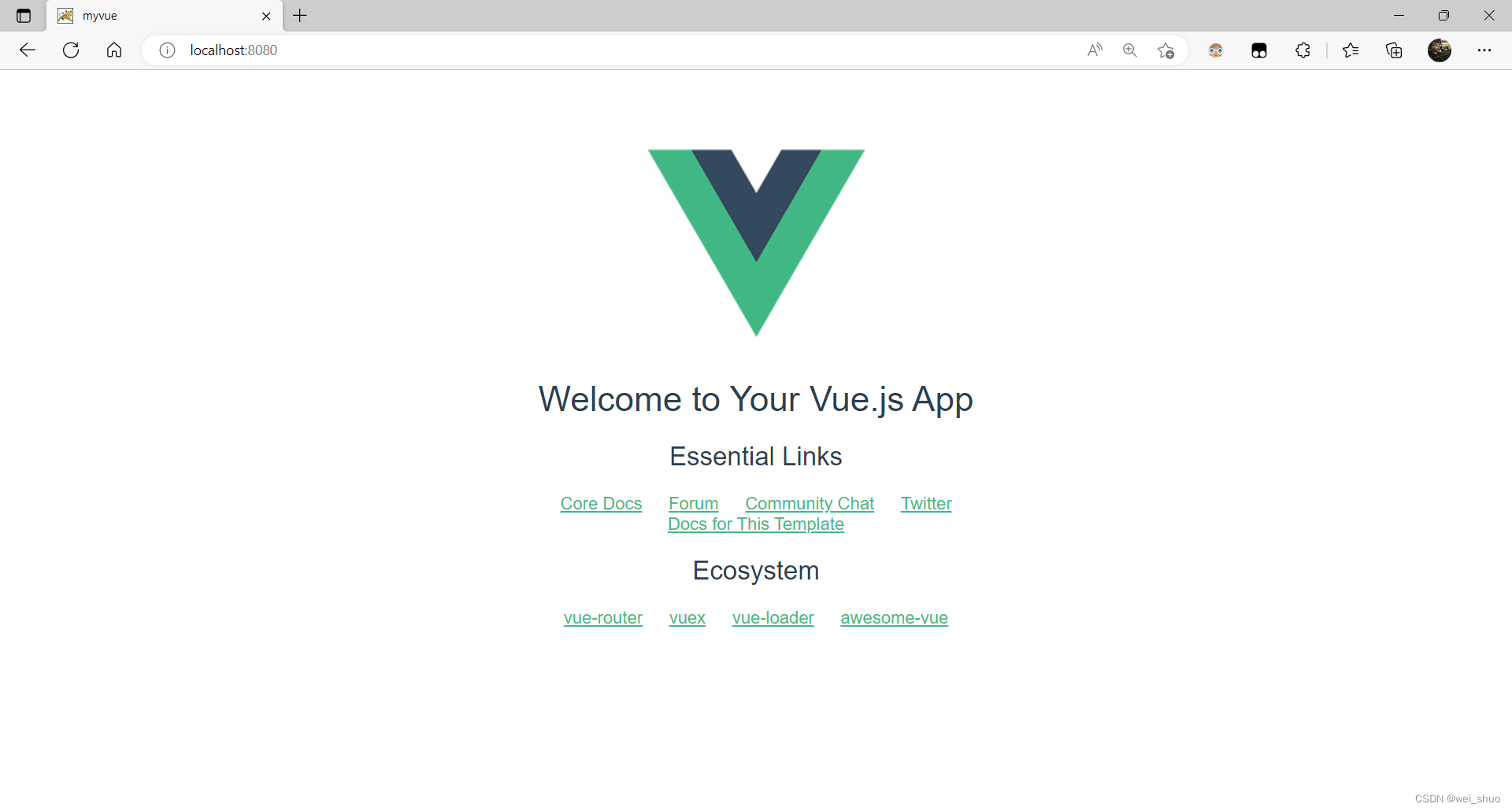
IDEA搭建vue-cli项目
直接用IDEA——OPEN——myvue目录即可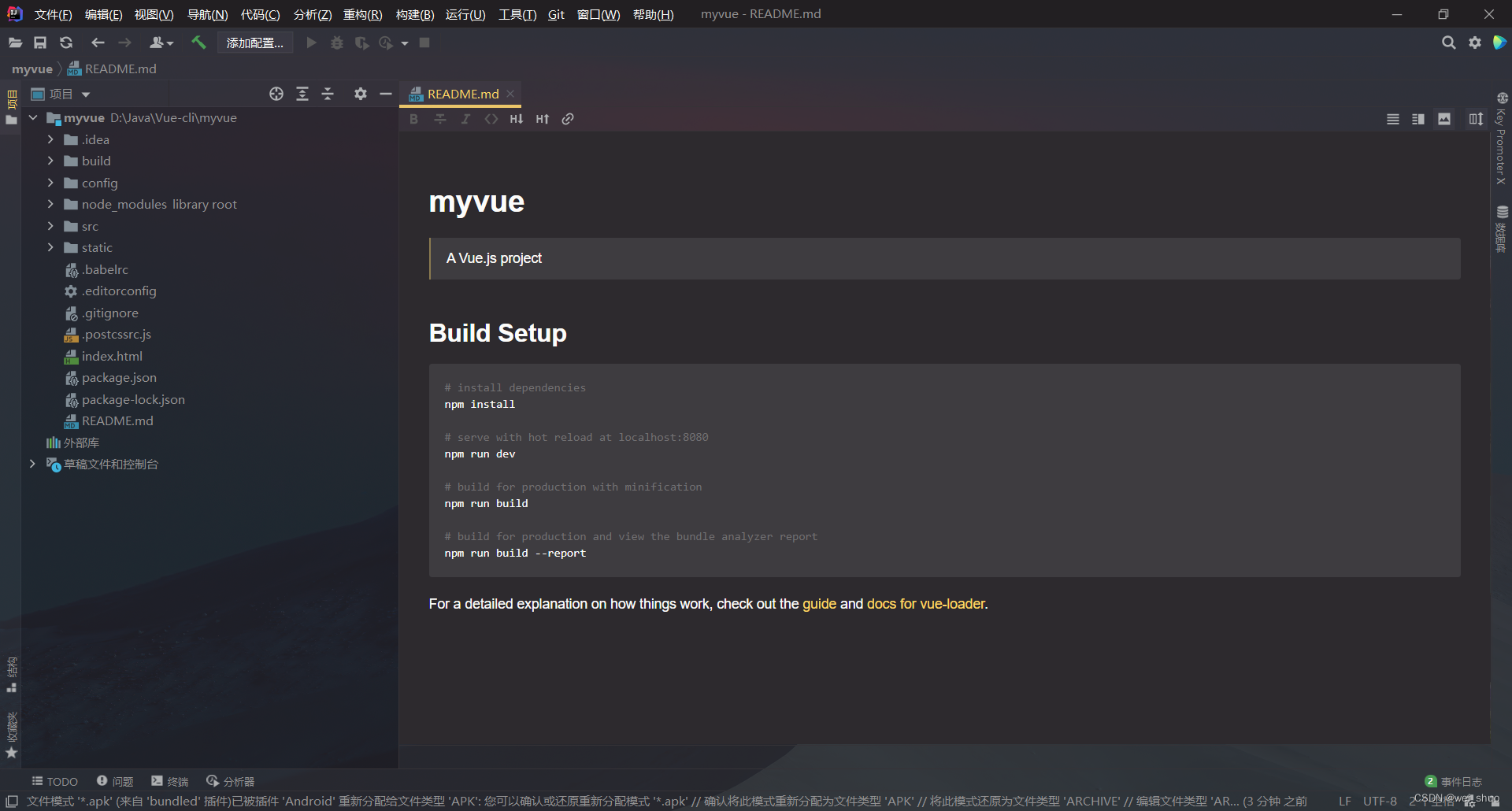
Webpack学习
webpack 是代码编译工具,有入口、出口、loader 和插件。webpack 是一个用于现代JavaScript应用程序的静态模块打包工具,当 webpack 处理应用程序时,它会在内部构建一个依赖图(dependency graph),此依赖图对应映射到项目所需的每个模块,并生成一个或多个 bundle。
安装Webpack
npm install webpack -gnpm install webpack-cli -g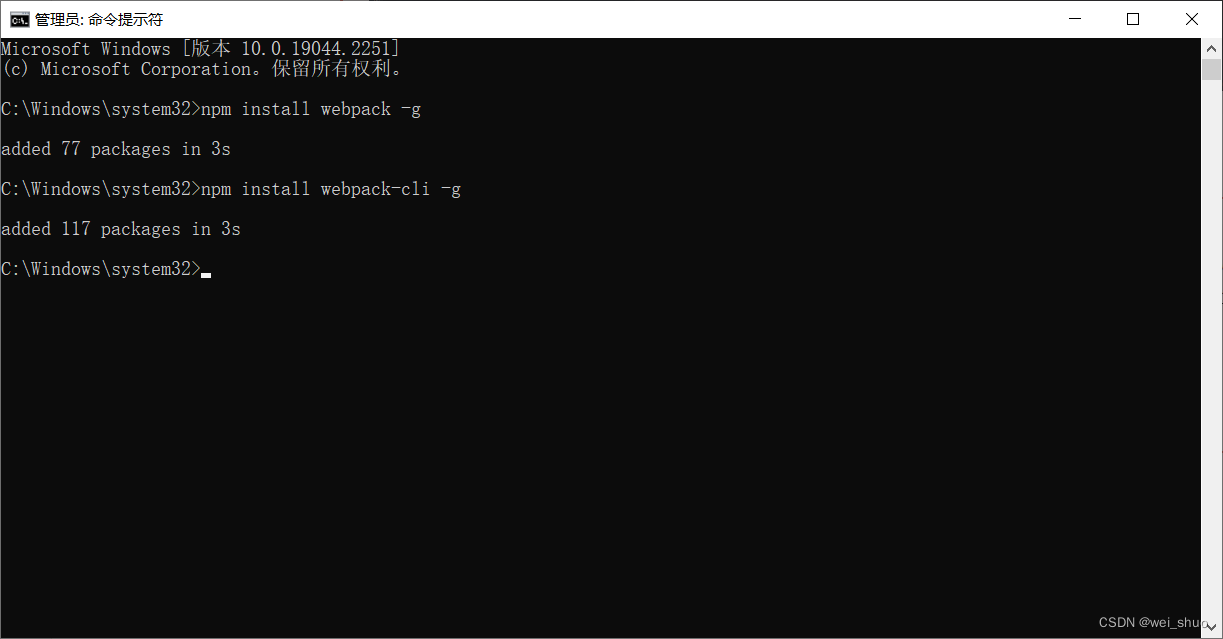
测试安装成功
webpack -vwebpack-cli -v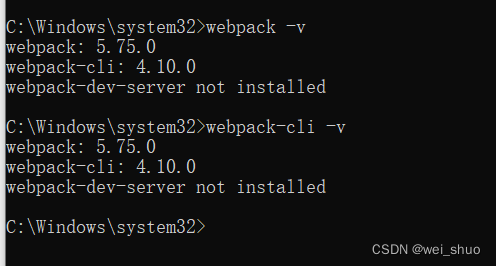
配置
创建webpack.config.js配置文件
entry:入口文件,指定webpack用哪个文件作为项目入口output:输出,指定webpack把处理完成的文件放置到指定路径module:模板,用于处理各类类型的文件plugins:插件,如:热更新、代码重用……resolve:设置路径指向watch:监听,用于设置文件改动后直接打包webpack使用
创建项目创建名为modules的目录,用于放置JS模板等资源文件modules下创建模板文件,用于编写JS模板相关代码(hello.js)//暴露一个方法exports.sayHi = function () { document.write("<h1>wei_shuo</h1>")}var hello = require("./hello");hello.sayHi();module.exports = { entry: './modules/main.js', output: { filename: "./js/bundle.js" }};(()=>{var r={645:(r,t)=>{t.sayHi=function(){document.write("<h1>wei_shuo</h1>>")}}},t={};(function e(o){var i=t[o];if(void 0!==i)return i.exports;var n=t[o]={exports:{}};return r[o](n,n.exports,e),n.exports})(645).sayHi()})();<!doctype html><html lang="en"><head> <meta charset="UTF-8"> <meta name="viewport" content="width=device-width, user-scalable=no, initial-scale=1.0, maximum-scale=1.0, minimum-scale=1.0"> <meta http-equiv="X-UA-Compatible" content="ie=edge"> <title>Document</title></head><body><!--前端的模块化开发--><script src="dist/js/bundle.js"></script></body></html>说明
参数 --watch 用于监听变化
webpack --watch
vue-router路由
Vue Router 是 Vue.js的官方路由。它与 Vue.js 核心深度集成,让用 Vue.js 构建单页应用变得轻而易举
功能:vue-router官方
嵌套路由映射动态路由选择模块化、基于组件的路由配置路由参数、查询、通配符展示由 Vue.js 的过渡系统提供的过渡效果细致的导航控制自动激活 CSS 类的链接HTML5 history 模式或 hash 模式可定制的滚动行为URL 的正确编码安装vue-router
基于第一个vue-cli进行测试学习;查看node_modules中是否存在vue-routervue-router是一个插件包,所以需要用npm&cnpm进行安装 打开IDEA终端,输入命令,安装vue-router npm install vue-router --save-dev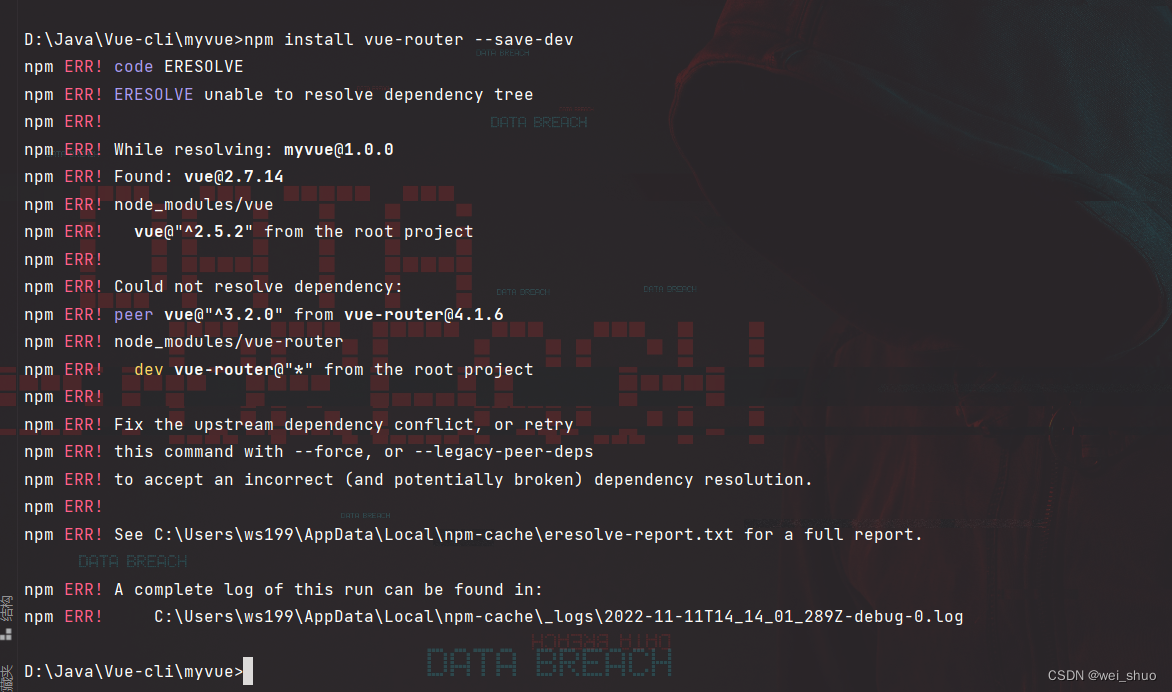
npm install --legacy-peer-deps vue-router --save-dev
npm audit fixto fix them,or npm audit for details;根据信息执行提示命令即可 npm audit fixnpm audit//导入安装的vue-router组件import VueRouter from 'vue-router'//显示声明使用VueRouterVue.use(VueRouter);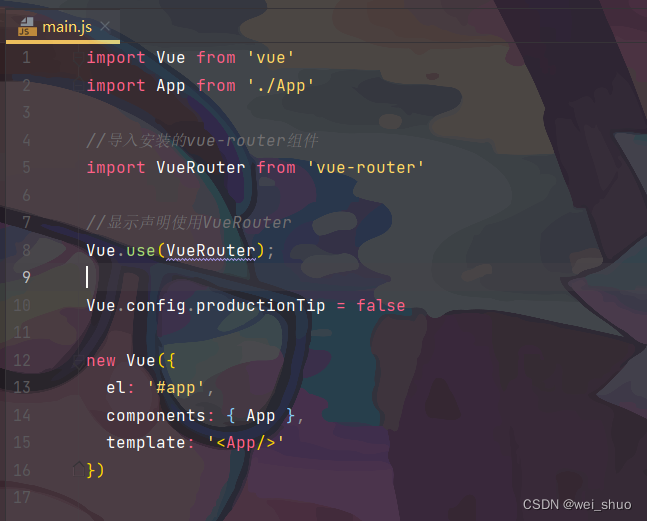
测试
IDEA终端运行项目npm run dev"export 'default' (imported as 'VueRouter') was not found in 'vue-router'
两种原因:
路由格式编写错误路由格式
routes: [{// 路径path: '/home',// 组件名component: Home}];安装的时候默认安装最新版本可能与其他插件不兼容,推荐使用稳定版本vue-router@3.5.2
卸载:npm uninstall vue-router 下载&降级:npm install vue-router@3.5.2 --save-dev// @xxx 自己指定版本

import Vue from 'vue'import App from './App'//导入安装的vue-router组件import VueRouter from 'vue-router'//显示声明使用VueRouterVue.use(VueRouter);Vue.config.productionTip = falsenew Vue({ el: '#app', components: { App }, template: '<App/>'})<template> <div id="app"> <h1>欢迎wei_shuo</h1> </div></template><script>export default { name: 'App'}</script><style>#app { font-family: 'Avenir', Helvetica, Arial, sans-serif; -webkit-font-smoothing: antialiased; -moz-osx-font-smoothing: grayscale; text-align: center; color: #2c3e50; margin-top: 60px;}</style>
vue-router使用
创建公共组件目录components
目录components下创建vue组件
Content.vue<!--页面编写--><template> <h1>内容页面</h1></template><!--vue对象--><script>export default { name: "Content"}</script><!--scoped作用域,添加scoped只在当前页面生效--><style scoped></style><template> <h1>首页</h1></template><script>export default { name: "Main"}</script><style scoped></style>创建存放路由的文件夹router
目录router创建router路由
index.js//导入vue和vue-router组件import Vue from "vue";import VueRouter from "vue-router";import Content from "../components/Content";import Main from "../components/Main";//安装路由Vue.use(VueRouter);//配置导出路由export default new VueRouter({ routes:[ { //路由路径 path:'/content', name:'content', //跳转组件 component:Content }, { //路由路径 path:'/main', name:'content', //跳转组件 component:Main } ]});配置路由
在main.js中配置路由
import Vue from 'vue'import App from './App'//导入配置路由文件import router from './router' //自动扫描里面的路由配置Vue.config.productionTip = falsenew Vue({ el: '#app', //配置路由 router, components: { App }, template: '<App/>'})使用路由
在App.vue中使用路由
<template> <div id="app"> <h1>欢迎wei_shuo</h1> <!--跳转连接--> <router-link to="/main">首页</router-link> <router-link to="/content">内容页面</router-link> <!--展示视图--> <router-view></router-view> </div></template><script>export default { name: 'App',}</script><style>#app { font-family: 'Avenir', Helvetica, Arial, sans-serif; -webkit-font-smoothing: antialiased; -moz-osx-font-smoothing: grayscale; text-align: center; color: #2c3e50; margin-top: 60px;}</style>vue-router使用流程
components目录下创建vue组件(wei.vue)<template> <h1>wei</h1></template><script>export default { name: "wei"}</script><style scoped></style>//导入vue和vue-router组件import Vue from "vue";import VueRouter from "vue-router";//导入components目录中vue组件import wei from "../components/wei"//安装路由Vue.use(VueRouter);//配置导出路由export default new VueRouter({ routes:[ { //路由路径 path:'/wei', //name 可省略 name:'content', //跳转组件 component:wei } ]});<template> <div id="app"> <h1>欢迎wei_shuo</h1> <!--跳转连接--> <router-link to="/wei">wei</router-link> <!--展示视图--> <router-view></router-view> </div></template><script>export default { name: 'App',}</script><style>#app { font-family: 'Avenir', Helvetica, Arial, sans-serif; -webkit-font-smoothing: antialiased; -moz-osx-font-smoothing: grayscale; text-align: center; color: #2c3e50; margin-top: 60px;}</style>import Vue from 'vue'import App from './App'//导入配置路由文件import router from './router' //自动扫描里面的路由配置Vue.config.productionTip = falsenew Vue({ el: '#app', //配置路由 router, components: { App }, template: '<App/>'})结果测试
网页点击首页 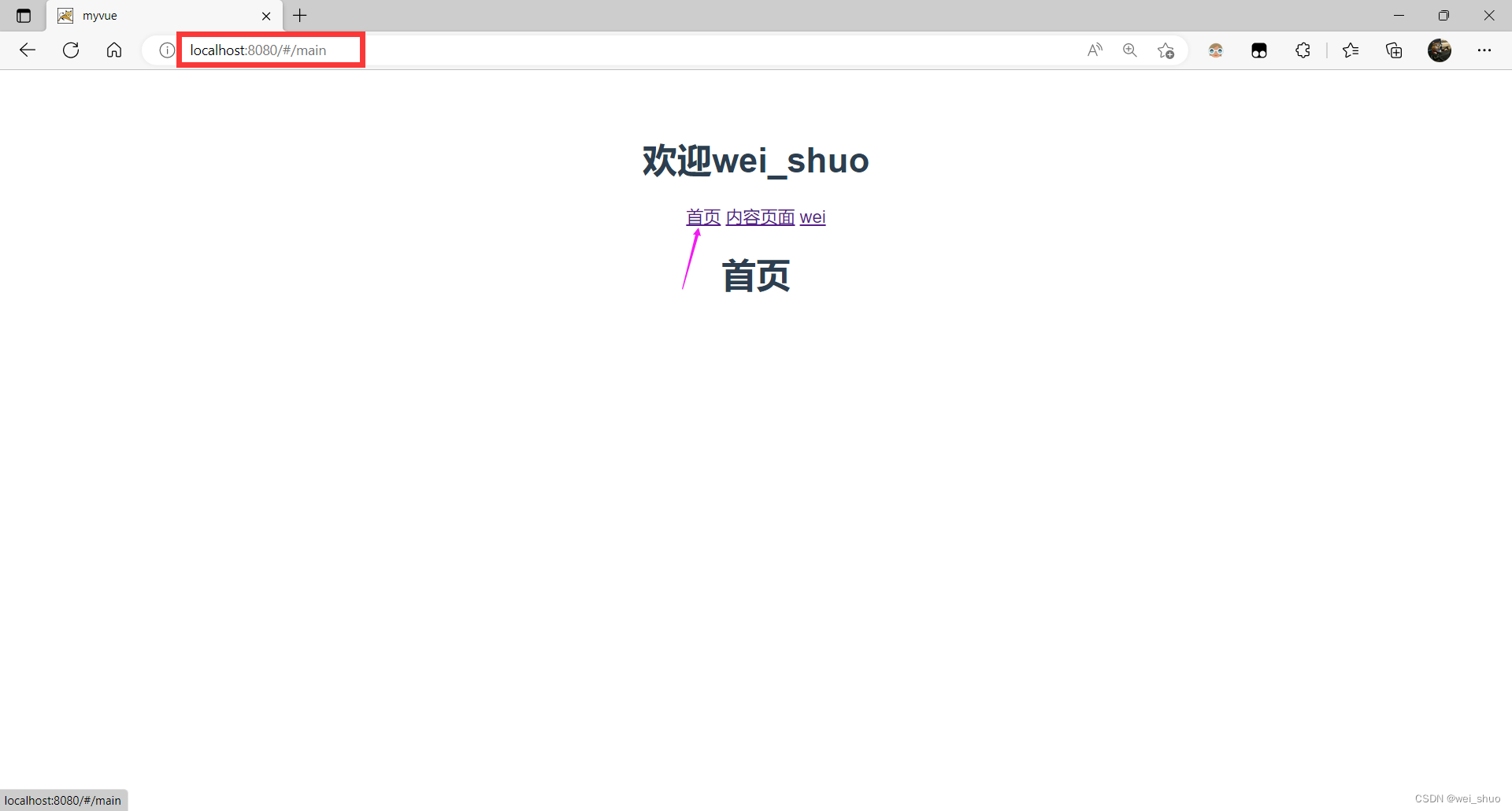
内容页面 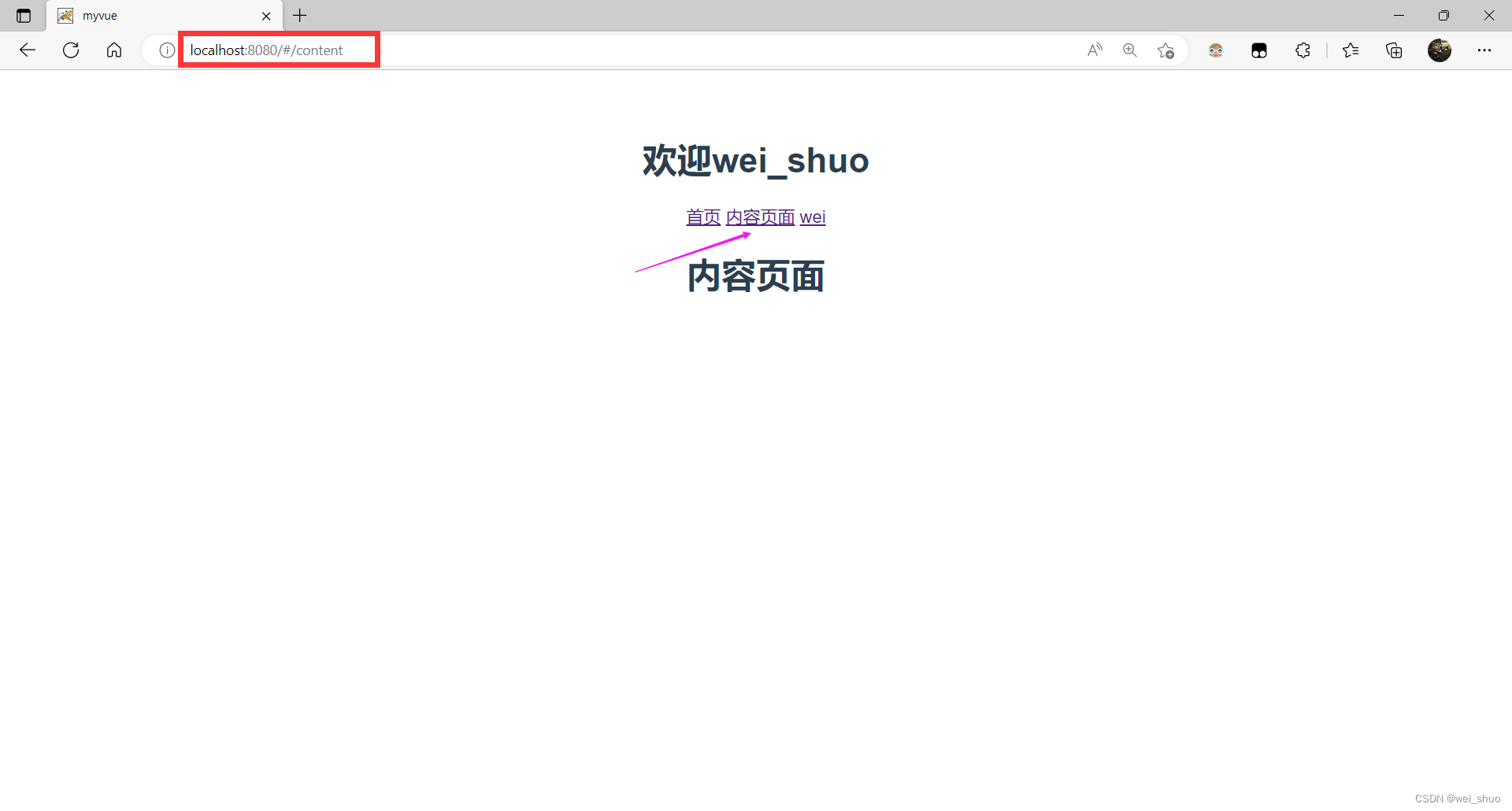
wei 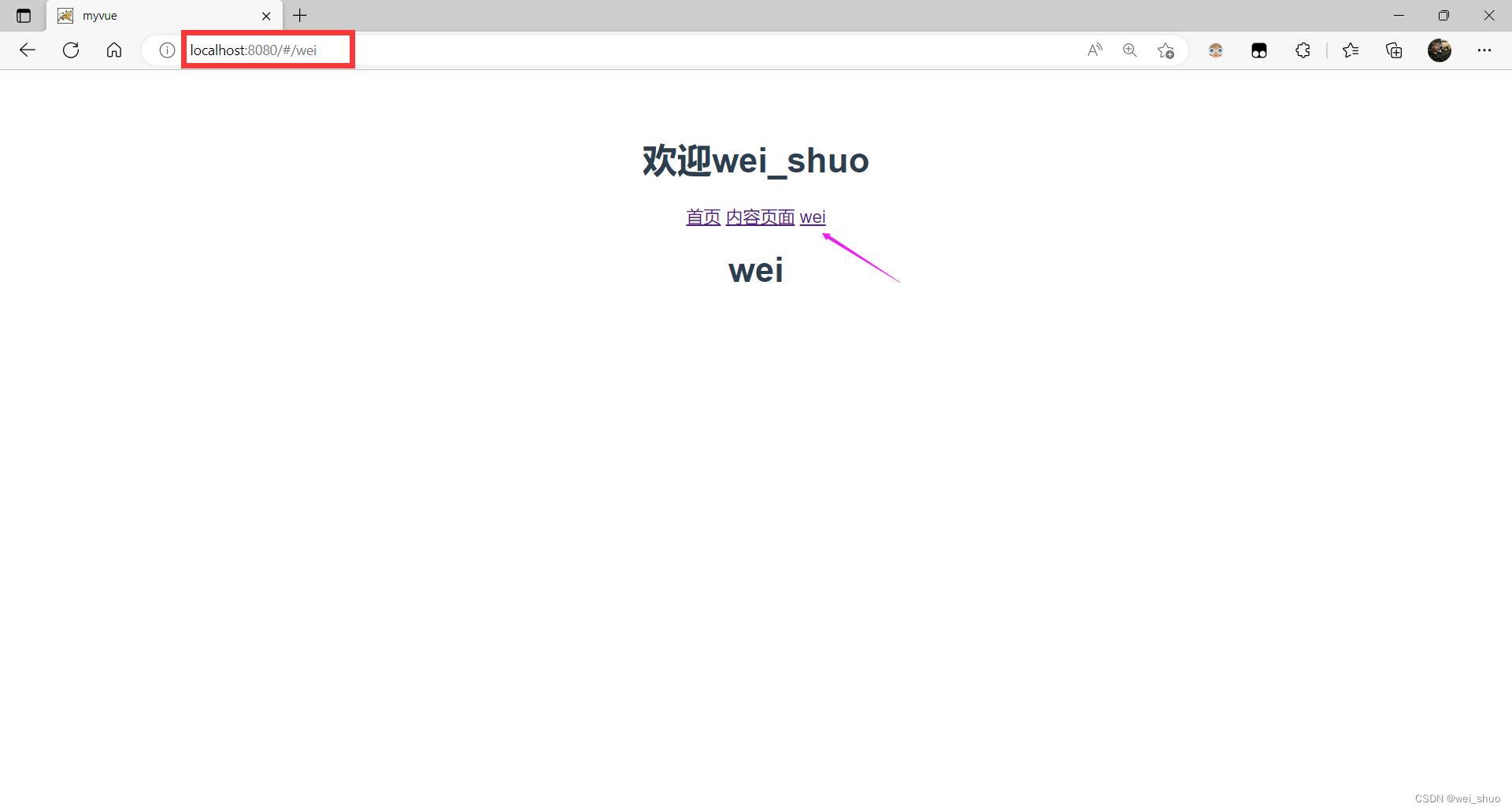
Axios
Axios 是一个基于 promise(异步编程的一种解决方案)网络请求库,作用于node.js和浏览器中, 它是 isomorphic(即同一套代码可以运行在浏览器和node.js中);服务端它使用原生 node.js http 模块,,而在客户端 (浏览端)则使用 XMLHttpRequests
异步编程:异步编程是让程序并发运行的一种手段
功能:Axios中文网
从浏览器创建XMLHttpRequests从 node.js 创建http请求支持Promise API拦截请求和响应转换请求和响应数据取消请求自动转换JSON数据客户端支持防御XSRF 安装
$ npm install axiosVue+ElementUI
Element,一套为开发者、设计师和产品经理准备的基于 Vue 2.0 的桌面端组件库
Element官网
创建工程
创建hello-vue工程vue init webpack hello-vue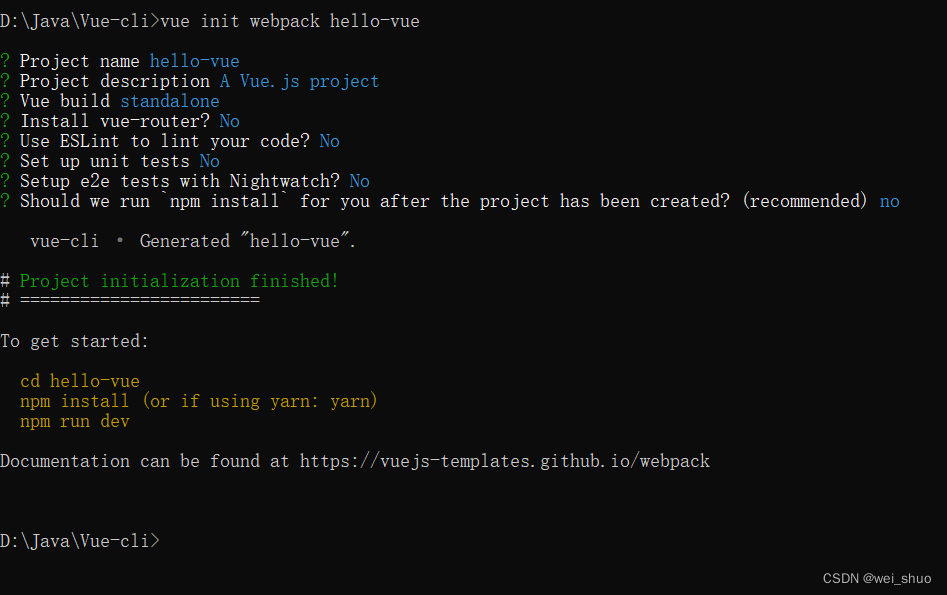

# 进入工程目录cd hello-vue# 安装 vue-routernpm install vue-router --save-dev# 安装 element-uinpm i element-ui -S# 安装依赖npm install# 安装 SASS 加载器cnpm install sass-loader node-sass --save-dev# 启动测试npm run devnpm install vue-router --save-dev --legacy-peer-deps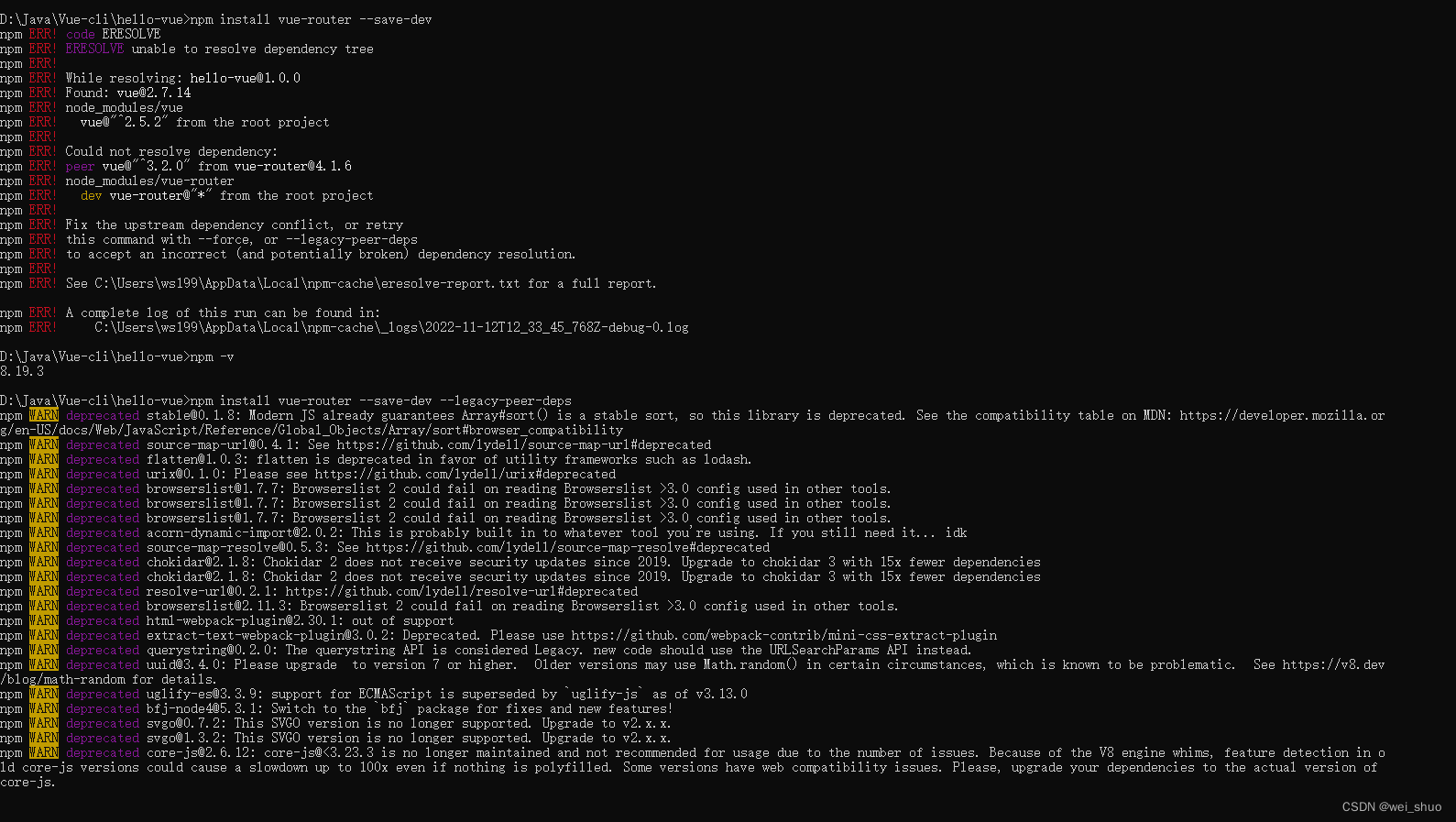
npm i element-ui -S --save-dev --legacy-peer-deps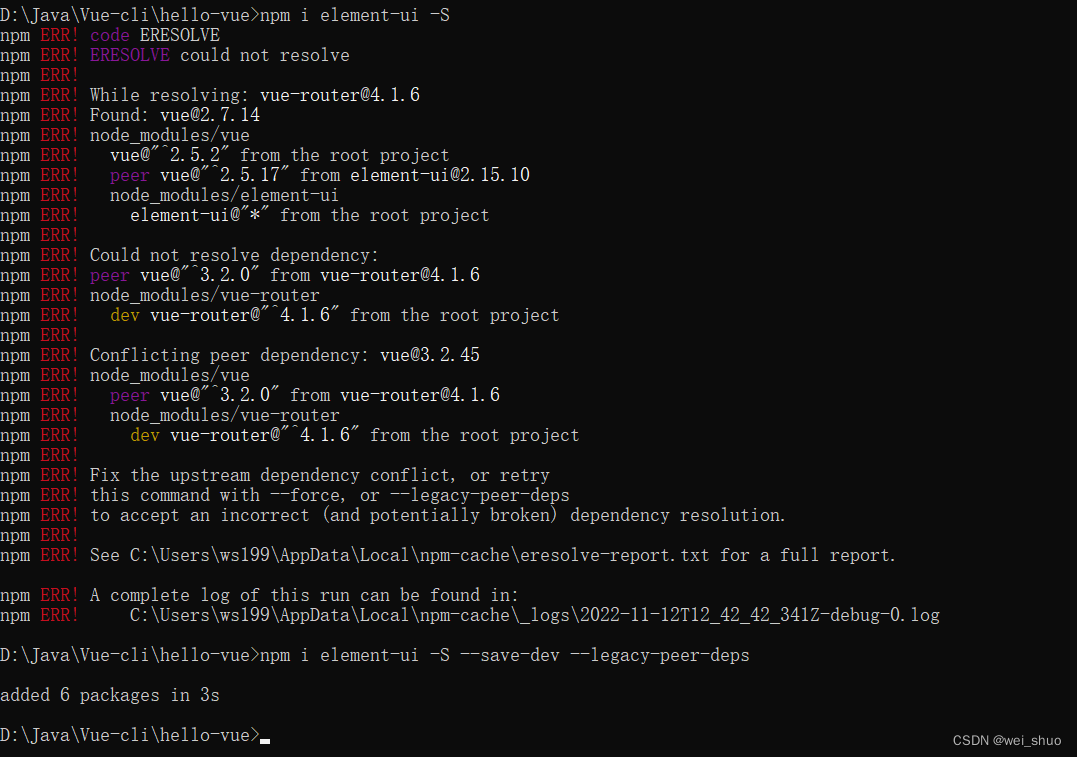
npm install --save-dev --legacy-peer-deps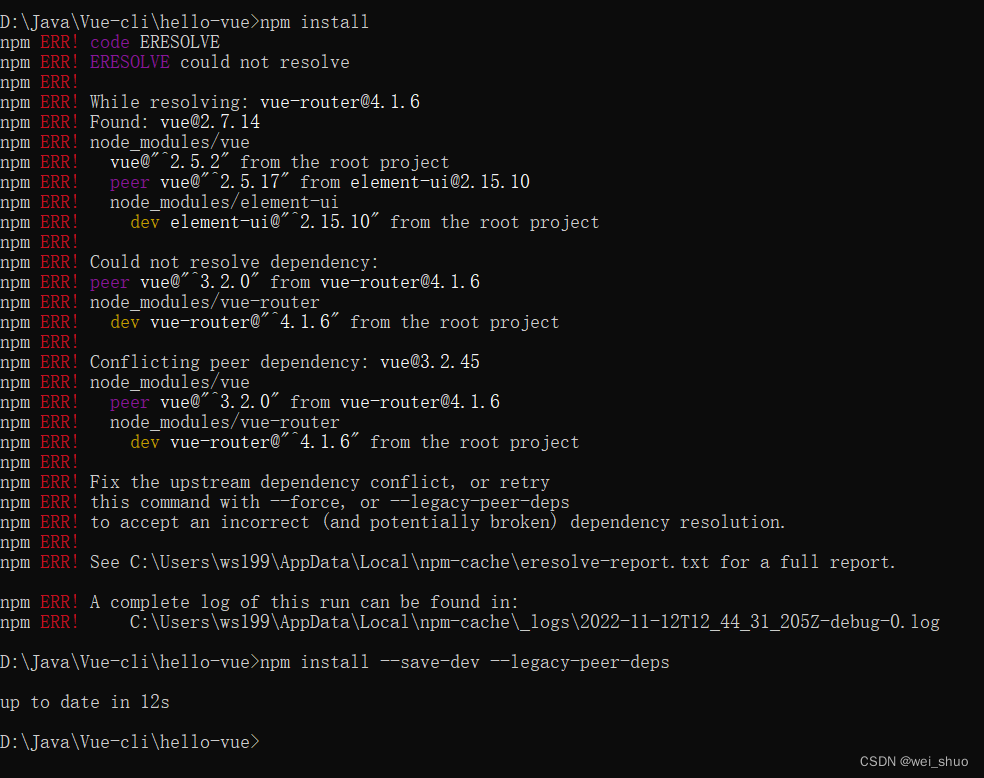
cnpm install sass-loader node-sass --save-dev
npm run dev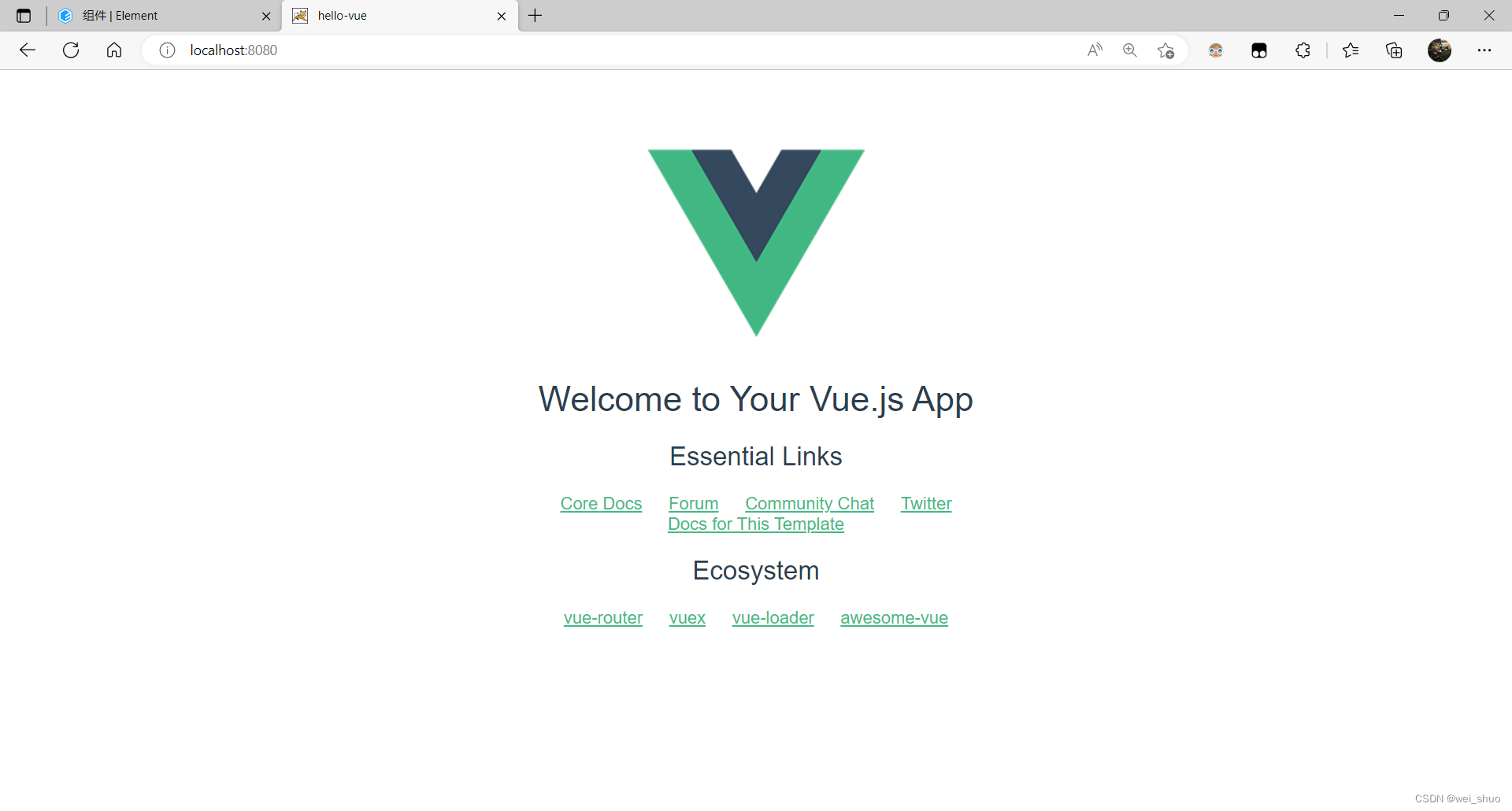
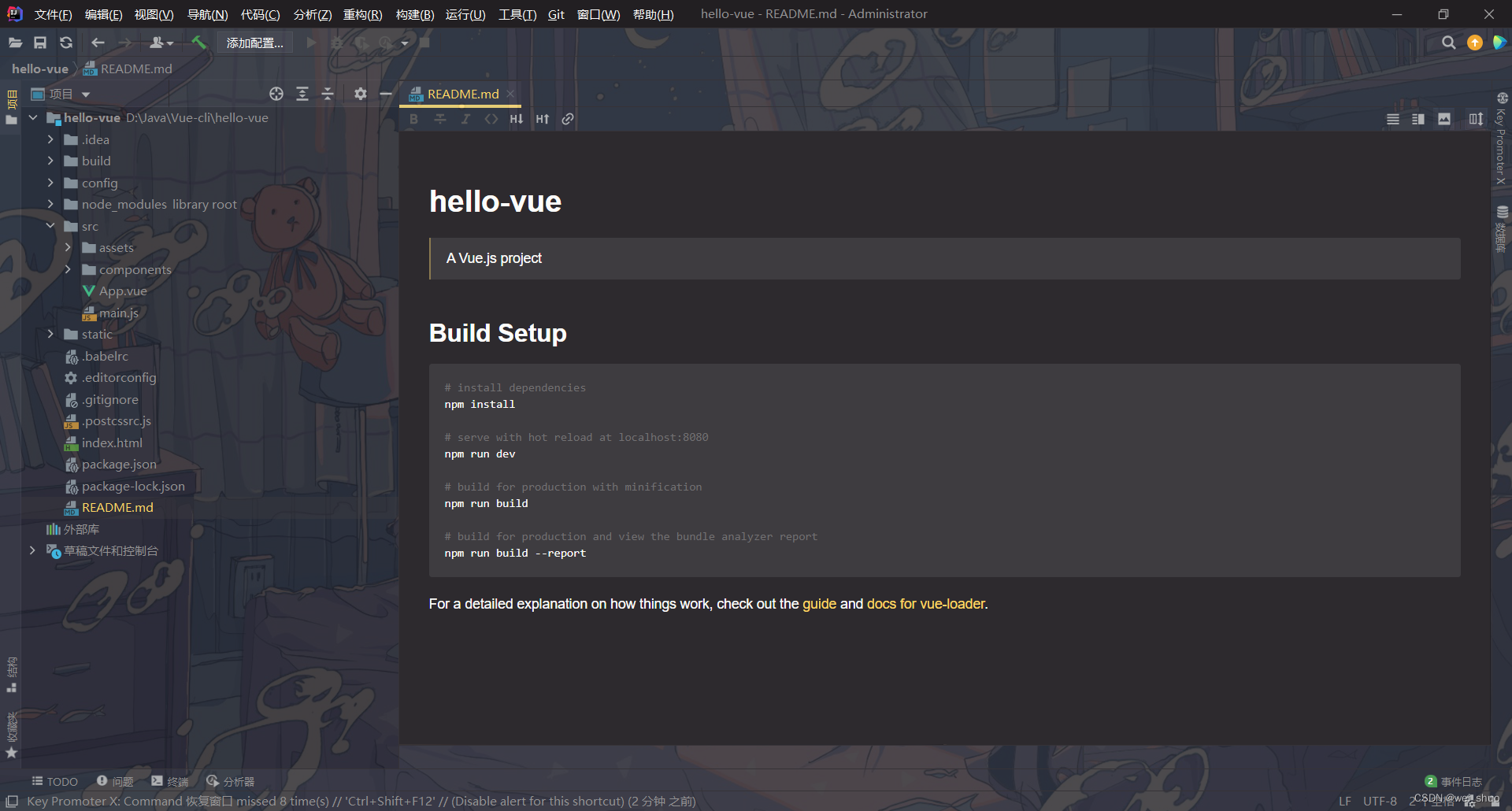
项目搭建
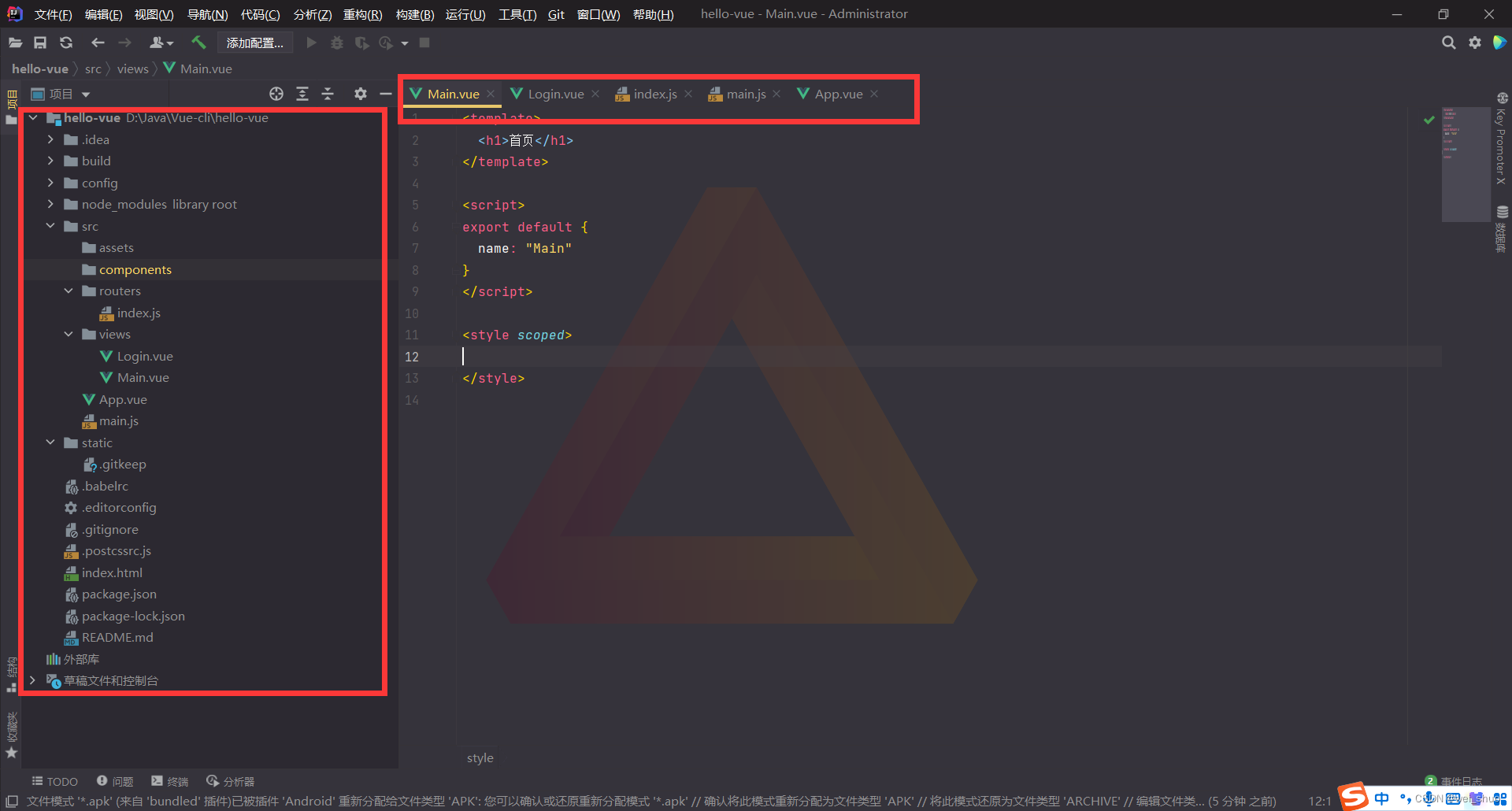
创建页面目录(views)和前端路由目录(routers)
页面目录(views)下创建
Main.vue(首页)
<template> <h1>首页</h1></template><script>export default { name: "Main"}</script><style scoped></style><template> <div> <el-form ref="loginForm" :model="form" :rules="rules" label-width="80px" class="login-box"> <h3 class="login-title">欢迎登录</h3> <el-form-item label="账号" prop="username"> <el-input type="text" placeholder="请输入账号" v-model="form.username"/> </el-form-item> <el-form-item label="密码" prop="password"> <el-input type="password" placeholder="请输入密码" v-model="form.password"/> </el-form-item> <el-form-item> <el-button type="primary" v-on:click="onSubmit('loginForm')">登录</el-button> </el-form-item> </el-form> <el-dialog title="温馨提示" :visible.sync="dialogVisible" width="30%" :before-close="handleClose"> <span>请输入账号和密码</span> <span slot="footer" class="dialog-footer"> <el-button type="primary" @click="dialogVisible = false">确 定</el-button> </span> </el-dialog> </div></template><script>export default { name: "Login", data() { return { form: { username: '', password: '' }, // 表单验证,需要在 el-form-item 元素中增加 prop 属性 rules: { username: [ {required: true, message: '账号不可为空', trigger: 'blur'} ], password: [ {required: true, message: '密码不可为空', trigger: 'blur'} ] }, // 对话框显示和隐藏 dialogVisible: false } }, methods: { onSubmit(formName) { // 为表单绑定验证功能 this.$refs[formName].validate((valid) => { if (valid) { // 使用 vue-router 路由到指定页面,该方式称之为编程式导航 this.$router.push("/main"); } else { this.dialogVisible = true; return false; } }); } }}</script><style lang="scss" scoped>.login-box { border: 1px solid #DCDFE6; width: 350px; margin: 180px auto; padding: 35px 35px 15px 35px; border-radius: 5px; -webkit-border-radius: 5px; -moz-border-radius: 5px; box-shadow: 0 0 25px #909399;}.login-title { text-align: center; margin: 0 auto 40px auto; color: #303133;}</style>//导入vue和vue-router组件import Vue from "vue";import Router from 'vue-router'//添加路由组件import Main from "../views/Main";import Login from "../views/Login";//使用vue-router组件Vue.use(Router)//导出默认接口路由export default new Router({ routes:[ { //路由路径 path:'/main', //跳转组件 component:Main }, { //路由路径 path:'/login', //跳转组件 component:Login } ]});import Vue from 'vue'import App from './App'//导入配置路由文件,自动扫描里面的路由配置import router from './routers'//导入ElementUIimport Element from 'element-ui'//导入ElementUI的CSSimport 'element-ui/lib/theme-chalk/index.css';//安装路由Vue.use(router);//安装ElementUIVue.use(Element)Vue.config.productionTip = falsenew Vue({ el: '#app', //路由 router, //ElementUI render: h => h(App)})<template> <div id="app"> <router-view></router-view> </div></template><script>export default { name: 'App'}</script>npm run dev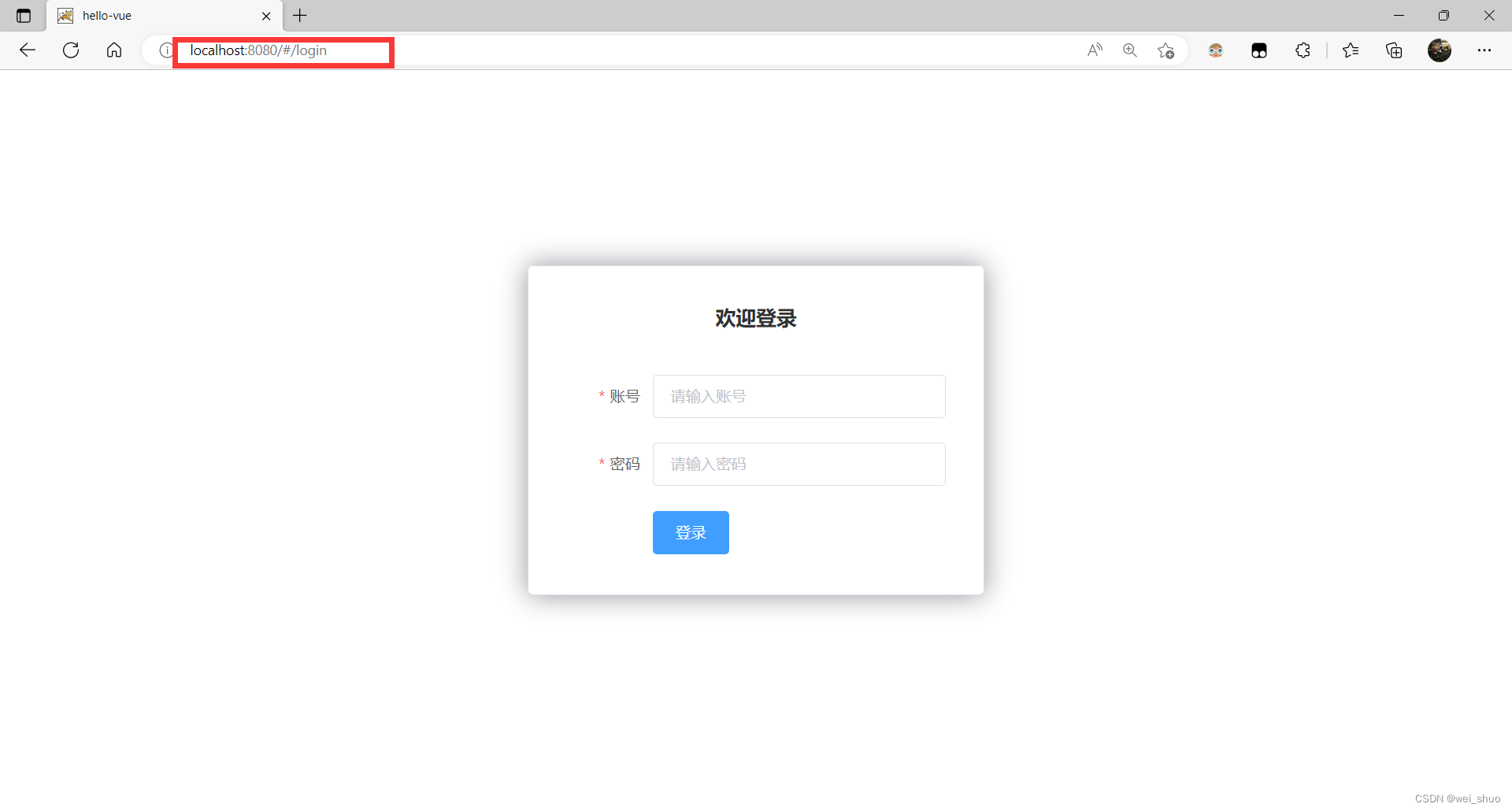
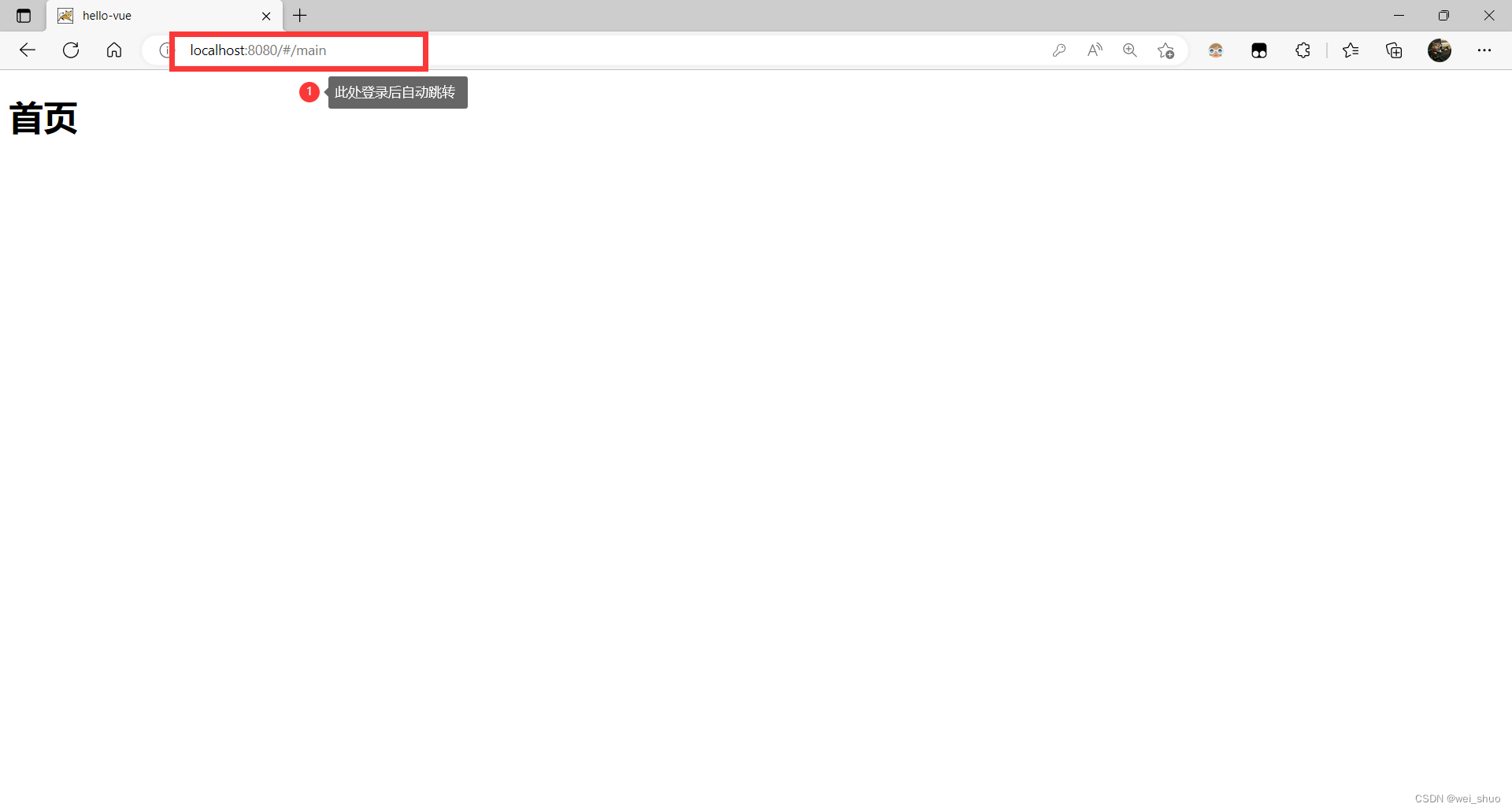
排错分析
排错一
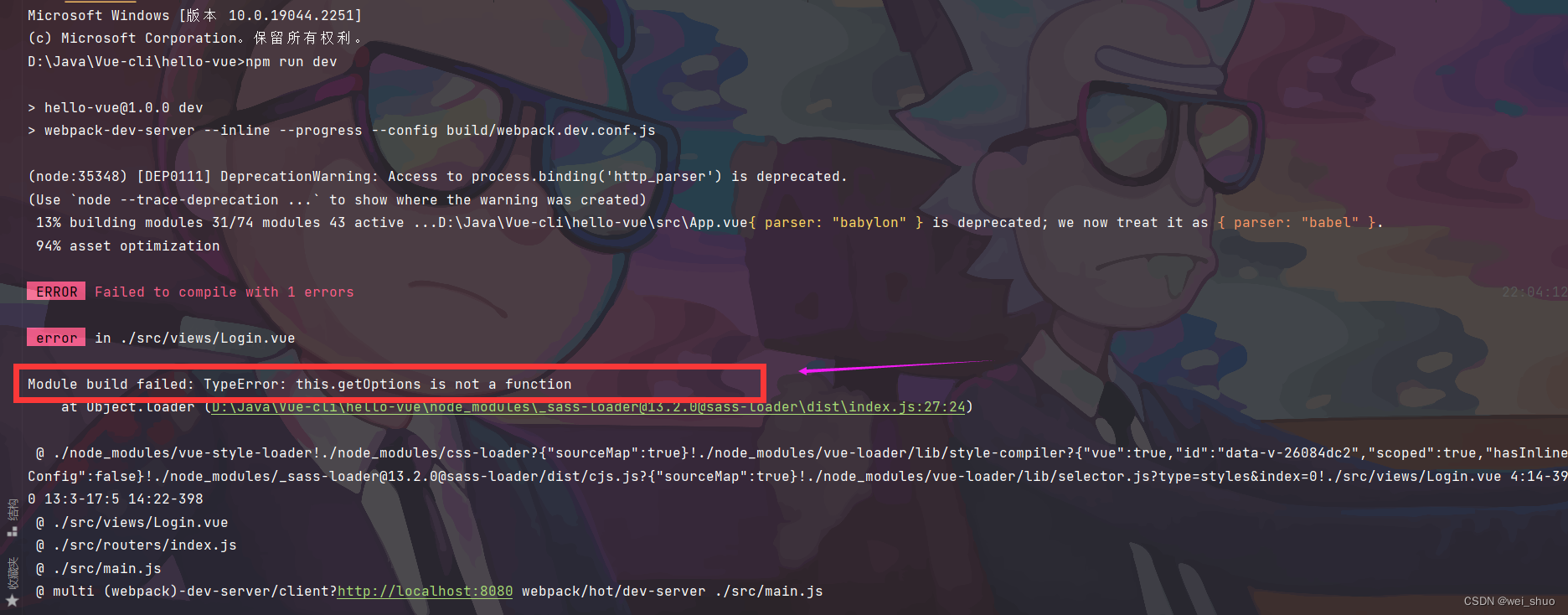
npm run dev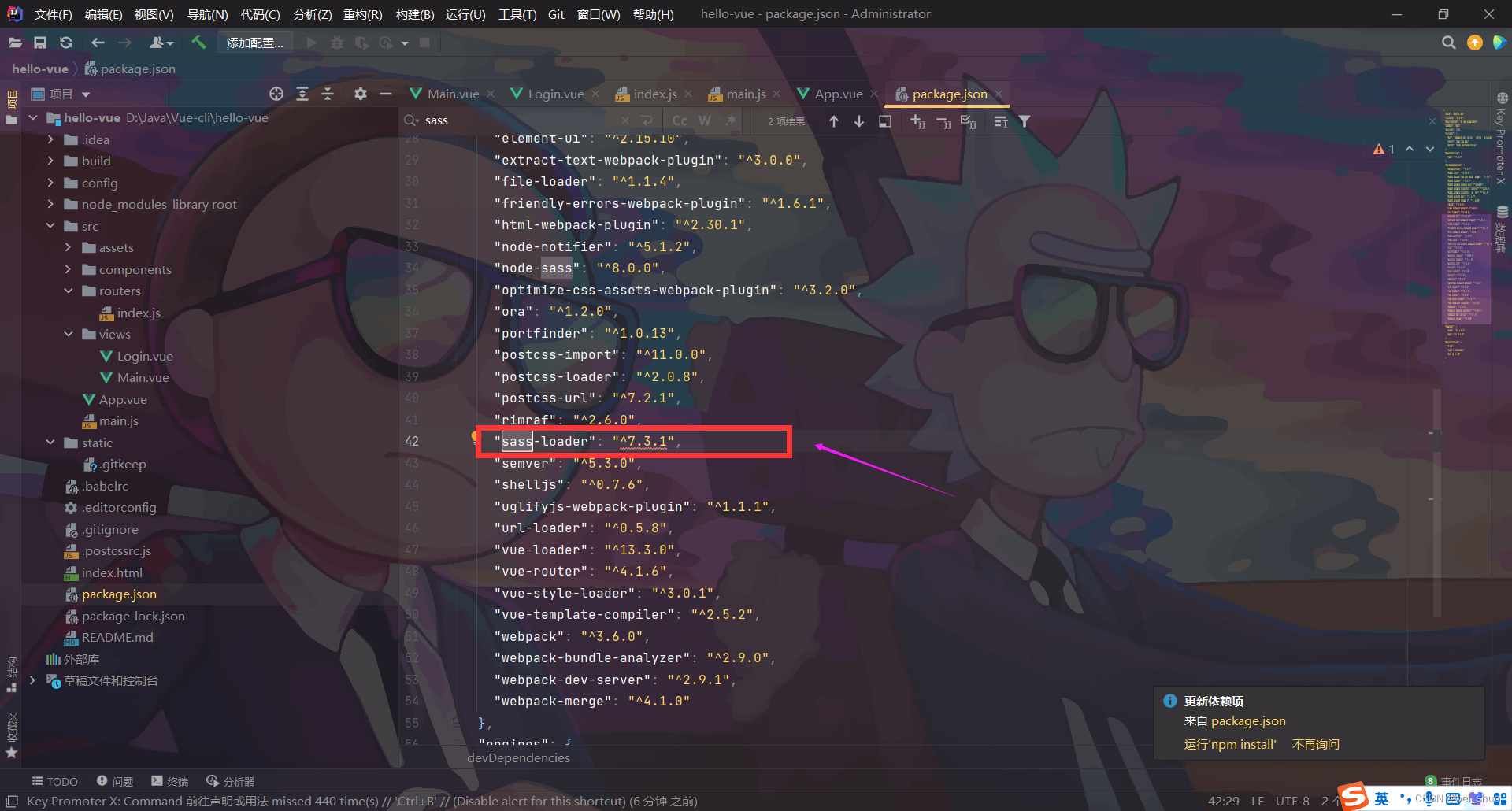
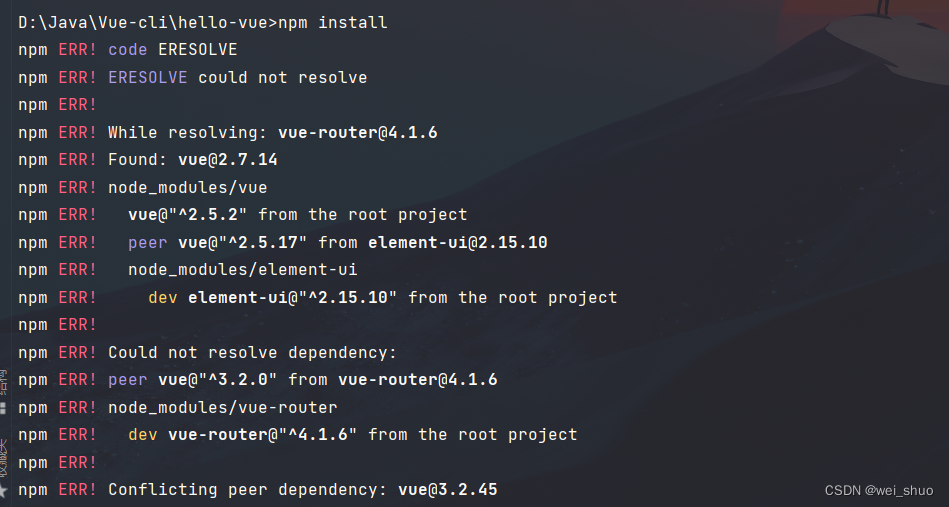
npm install --legacy-peer-deps
排错二

Module build failed: Error: Node Sass version 8.0.0 is incompatible with ^4.0.0.// 卸载node-sassnpm uninstall node-sass --legacy-peer-deps// 然后安装需求版本cnpm install node-sass@4.14.1 --legacy-peer-deps排错三
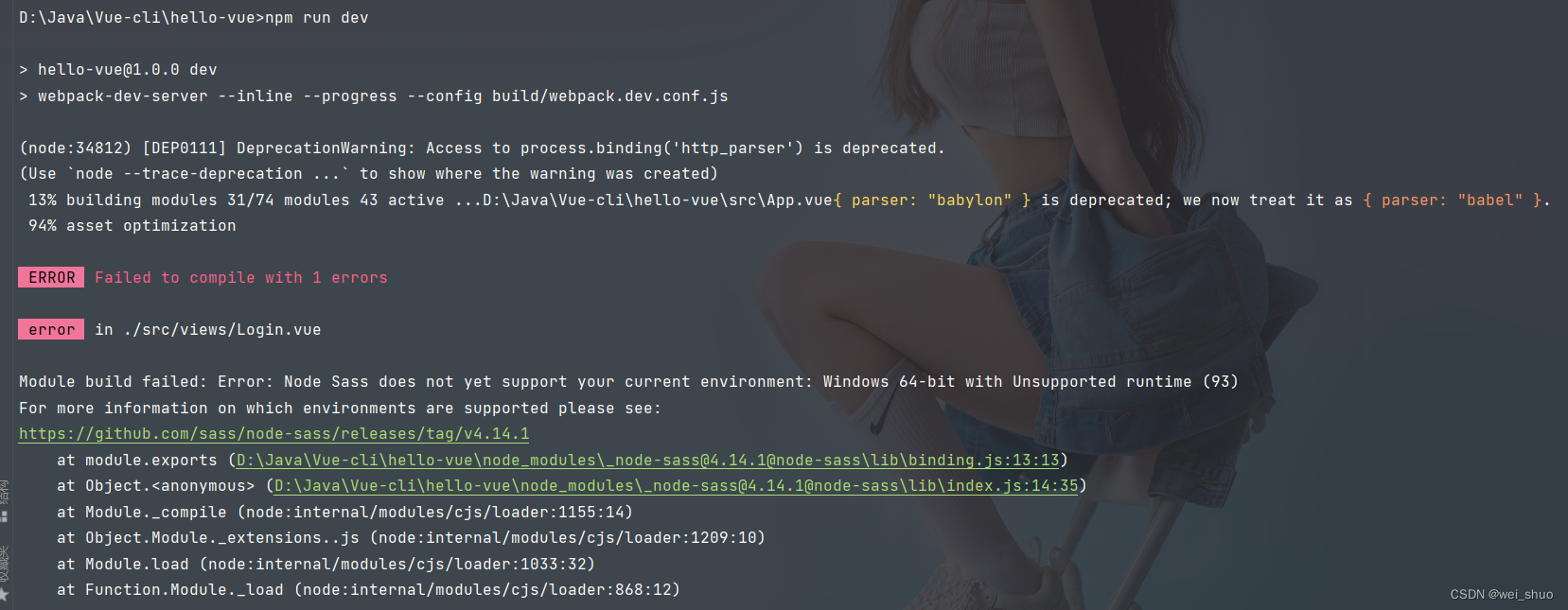
Module build failed: Error: Node Sass does not yet support your current environment: Windows 64-bit with Unsupported runtime (93)查看本机安装的node版本安装对应的node-sass版本
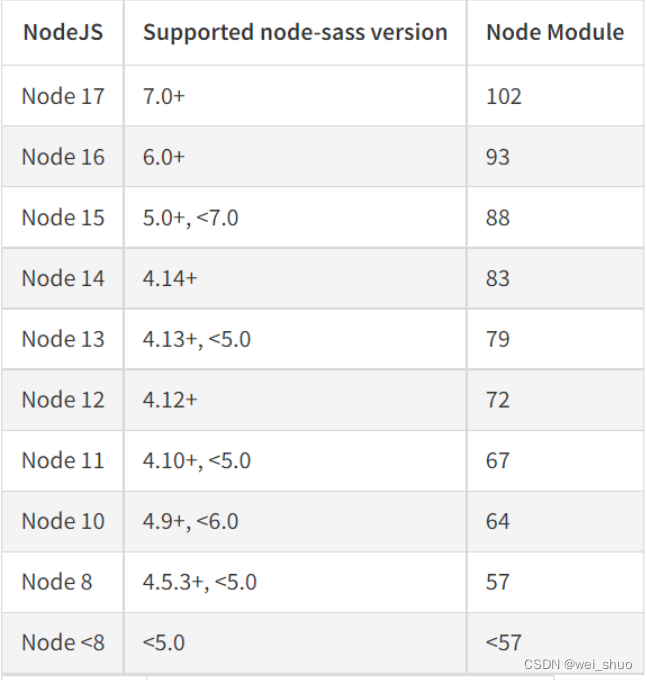
node版本:v14.18.3node-sass版本:4.7.2sass-loader版本:7.3.1node版本:16.13.1node-sass版本:6.0.1sass-loader版本:10.0.1D:\Java\Vue-cli\hello-vue>node -vv16.18.0安装node-sass 6.0+版本(6.0.1)
package.json调整版本
"sass-loader": "^6.0.1"npm install --legacy-peer-depscnpm install node-sass@6.0.1 --legacy-peer-deps排错四
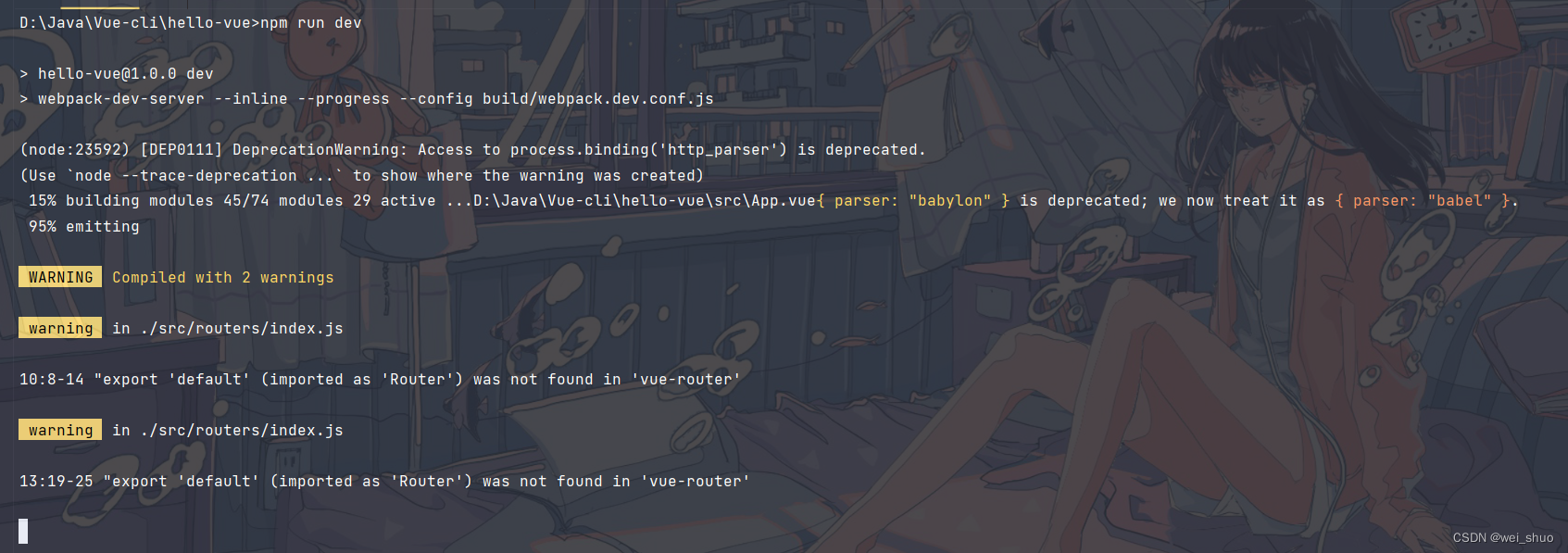
"export 'default' (imported as 'Router') was not found in 'vue-router'routes: [{// 路径path: '/home',// 组件名component: Home}]; 卸载:npm uninstall vue-router 下载&降级:npm install vue-router@3.5.2 --save-dev// @xxx 自己指定版本降级之后,需要使用命令更新依赖
npm install --legacy-peer-deps排错总结
版本问题,更改package.json版本后,需要执行更新依赖的命令npm install --legacy-peer-deps--legacy-peer-deps运行项目
运行项目npm run devvue项目目录分析
build:构建脚本目录
config:项目配置
node_modules:npm加载项目的依赖模块
src:源码目录
main.js——入口js文件App.vue——根组件components——共组件目录assets——资源目录,这里的资源会被wabpack构建routes——前端路由store——应用级数据(state)views——页面目录static:静态资源目录,不会被webpack构建
package.json:npm包配置文件,定义项目的npm脚本、依赖包等信息
README.md:项目的说明文档,markdown格式
npm命令解析
安装模块到项目下npm install moduleNamenpm install -g moduleNamenpm install --save moduleNamenpm install --save-dev moduleName路由嵌套
嵌套路由(子路由),实际应用中,通常由多层嵌套的组件组合而成,同样的URL中各段动态路径也按某种结构对应嵌套的各层组件
/user/johnny/profile /user/johnny/posts+------------------+ +-----------------+| User | | User || +--------------+ | | +-------------+ || | Profile | | +------------> | | Posts | || | | | | | | || +--------------+ | | +-------------+ |+------------------+ +-----------------+项目结构
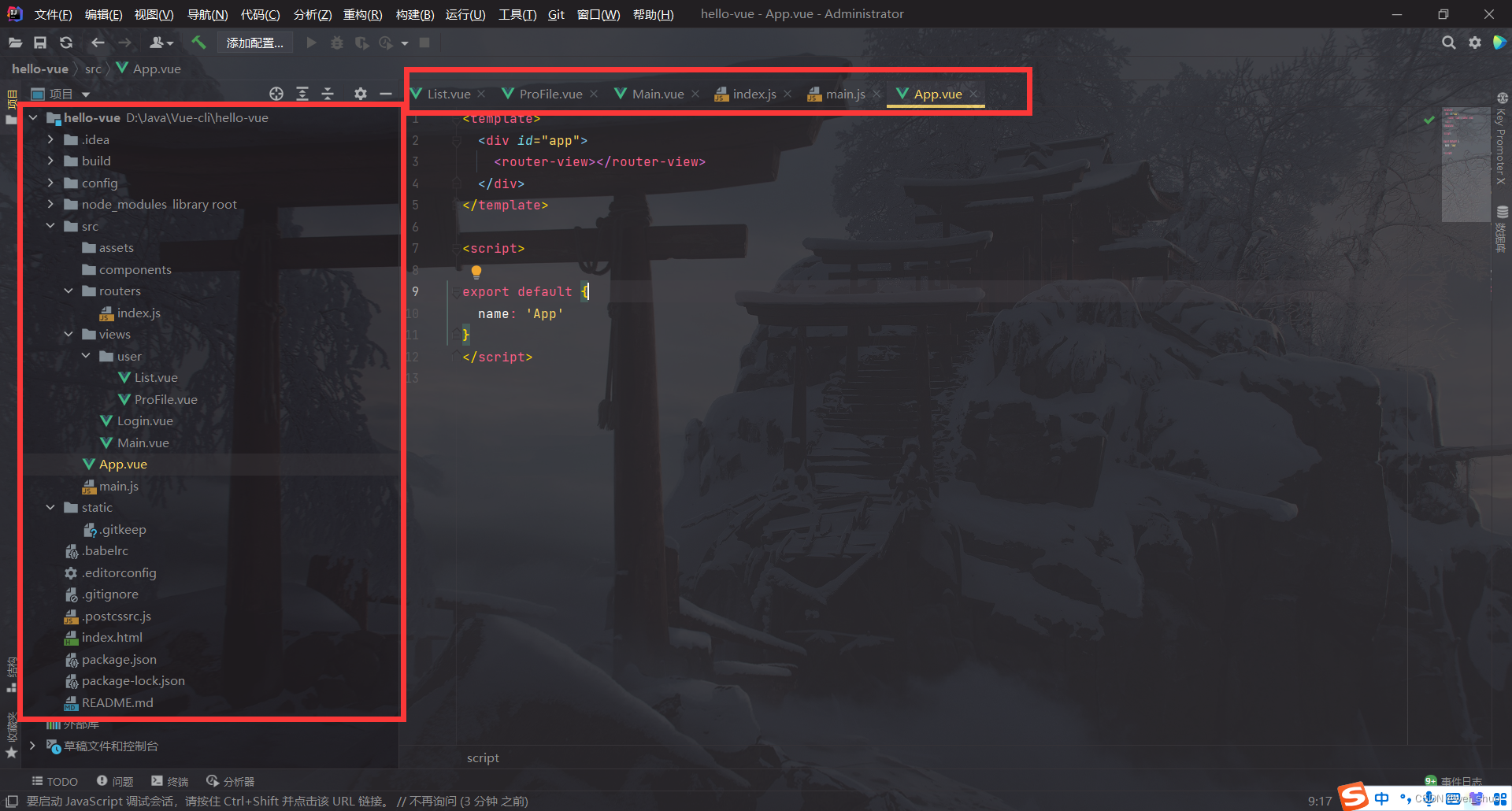
创建页面目录(views)和前端路由目录(routers)
页面目录(views)下创建,user目录
main.vue(首页)
<template> <div> <el-container> <el-aside width="200px"> <el-menu :default-openeds="['1']"> <el-submenu index="1"> <template slot="title"><i class="el-icon-caret-right"></i>用户管理</template> <el-menu-item-group> <el-menu-item index="1-1"> <!--插入的地方--> <router-link to="/user/profile">个人信息</router-link> </el-menu-item> <el-menu-item index="1-2"> <!--插入的地方--> <router-link to="/user/list">用户列表</router-link> </el-menu-item> </el-menu-item-group> </el-submenu> <el-submenu index="2"> <template slot="title"><i class="el-icon-caret-right"></i>内容管理</template> <el-menu-item-group> <el-menu-item index="2-1">分类管理</el-menu-item> <el-menu-item index="2-2">内容列表</el-menu-item> </el-menu-item-group> </el-submenu> <el-submenu index="3"> <template slot="title"><i class="el-icon-caret-right"></i>系统管理</template> <el-menu-item-group> <el-menu-item index="3-1">系统信息</el-menu-item> <el-menu-item index="3-2">系统内容</el-menu-item> </el-menu-item-group> </el-submenu> </el-menu> </el-aside> <el-container> <el-header style="text-align: right; font-size: 12px"> <el-dropdown> <i class="el-icon-setting" style="margin-right: 15px"></i> <el-dropdown-menu slot="dropdown"> <el-dropdown-item>个人信息</el-dropdown-item> <el-dropdown-item>退出登录</el-dropdown-item> </el-dropdown-menu> </el-dropdown> </el-header> <el-main> <!--在这里展示视图--> <router-view/> </el-main> </el-container> </el-container> </div></template><script>export default { name: "Main"}</script><style scoped lang="scss">.el-header { background-color: #B3C0D1; color: #333; line-height: 60px;}.el-aside { color: #333;}</style><template> <h1>个人信息</h1></template><script>export default { name: "UserProFile"}</script><style scoped></style><template> <h1>用户列表</h1></template><script>export default { name: "UserList"}</script><style scoped></style>//导入vue和vue-router组件import Vue from "vue";import Router from 'vue-router'//添加路由组件import Main from "../views/Main"import Login from "../views/Login"import UserList from '../views/user/List'import UserProFile from '../views/user/ProFile'//使用vue-router组件Vue.use(Router)//导出默认接口路由export default new Router({ routes: [ { //路由路径 path: '/main', //跳转组件 component: Main, //嵌套路由 children: [ {path: '/user/profile', component: UserProFile}, {path: '/user/list', component: UserList} ] }, { //路由路径 path: '/login', //跳转组件 component: Login } ]});import Vue from 'vue'import App from './App'//导入配置路由文件,自动扫描里面的路由配置import router from './routers'//导入ElementUIimport Element from 'element-ui'//导入ElementUI的CSSimport 'element-ui/lib/theme-chalk/index.css';//安装路由Vue.use(router);//安装ElementUIVue.use(Element)Vue.config.productionTip = falsenew Vue({ el: '#app', //路由 router, //ElementUI render: h => h(App)})<template> <div id="app"> <router-view></router-view> </div></template><script>export default { name: 'App'}</script>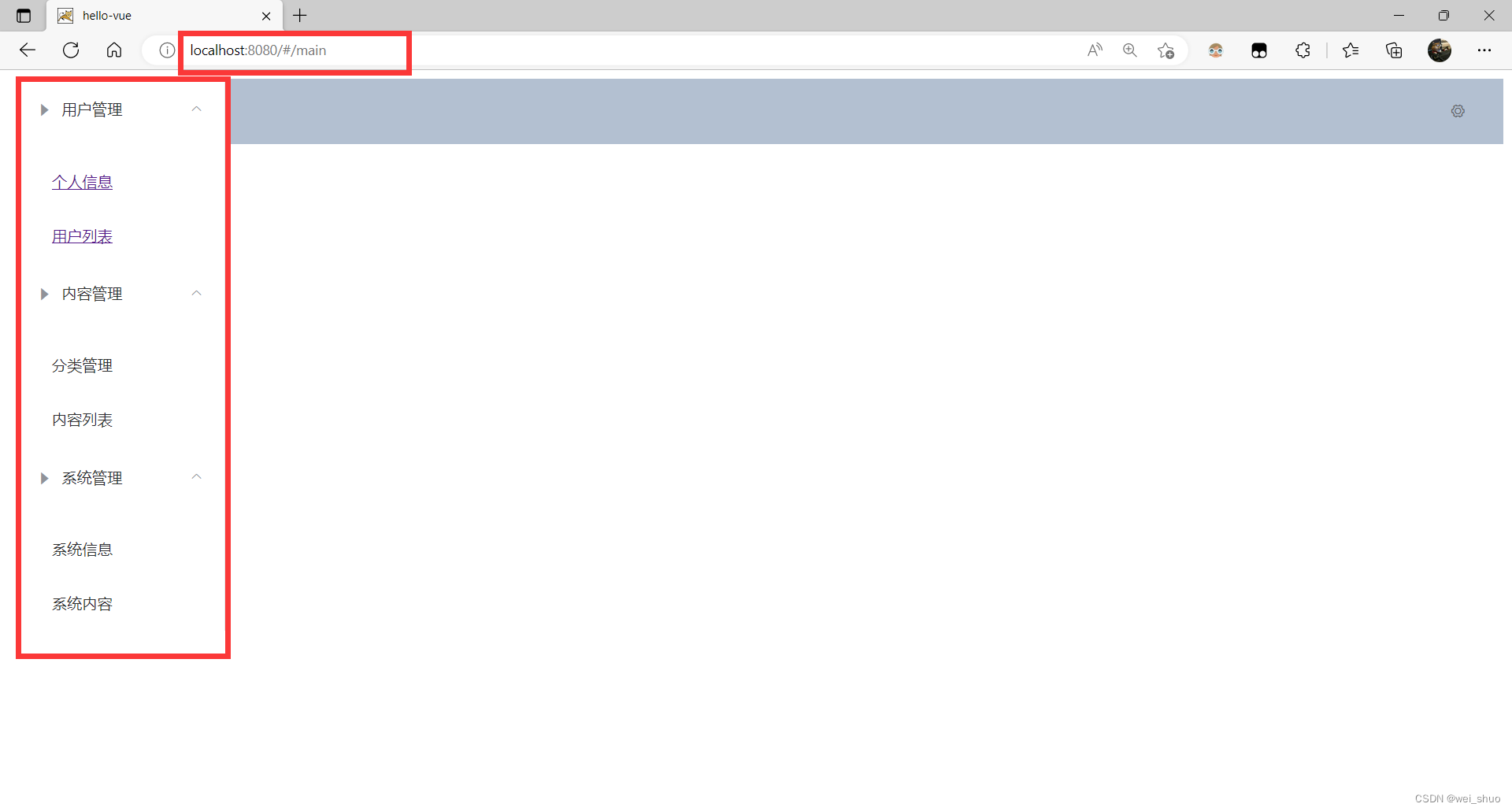
路由模式
hash:带路径#符号,如:http://localhost/#/loginhistory:路径不带#符号,如:http://localhost/loginexport default new Router({ mode:'history', routes: [ ]});参数传递&重定向
参数传递
Main.vue<!--插入的地方 name:传递组件名 params:传递参数--><router-link v-bind:to="{name:'UserProFile',params:{id:1}}">个人信息</router-link><template> <div> <h1>个人信息</h1> <!--{{ 方式一:$route.params.id }}--> {{id}} </div></template><script>export default { //方式二: props:['id'], name: "UserProFile"}</script><style scoped></style>重定向
//导出默认接口路由export default new Router({ mode:'history', routes: [ //重定向 { path:'/goHome', redirect:'/main'//重定向路径 } ]});404页面
views页面目录,创建404页面NotFound.vue<template> <div> <h1>404,你的页面走丢了!</h1> </div></template><script>export default { name: "NotFound"}</script><style scoped></style>import NotFound from "../views/NotFound"//导出默认接口路由export default new Router({ mode:'history', routes: [ { path:'/*', component:NotFound } ]});路由钩子&异步请求
路由钩子
beforeRouteEnter:在进入路由前执行
beforeRouteLeave:在离开路由前执行
to:路由将要跳转的路径信息from:路径跳转前的路径信息next:路由的控制参数 next() 跳入下一个页面next(‘/path’) 改变路由的跳转方向,使其跳到另一个路由next(false) 返回原来页面next((vm)=>{}) 仅在beforeRouteEnter中使用,vm是组件实例<script>export default { //进入路由之前执行 beforeRouteEnter:(to,from,next)=>{ console.log("STARE"); next(); }, //进入路由之后执行 beforeRouteLeave:(to,from,next)=>{ console.log("END"); next(); }}</script>异步请求
安装Axios和vue-axioscnpm install axios -scnpm install --save vue-axios//导入Axiosimport axios from 'axios'import VueAxios from 'vue-axios'//安装axios和VueAxiosVue.use(VueAxios, axios)Vue工程化项目目录结构
node_modules 通过npm install命令安装的软件包存放的目录(非全局安装)
dist 项目打包发布目录
public 最后打包时,该目录中的文件会直接复制到dist目录中
public/index.html 首页入口文件public/favicon.ico 图标文件src
src/assets 静态资源文件目录
src/components 组件文件目录
src/router 路由插件目录
src/router/index.js 路由插件配置文件src/store 状态管理插件目录
src/store/index.js 状态管理插件配置文件src/plugins 插件目录,一般存放axios.js插件文件
src/views 组件文件目录(仅仅具有模板和样式,没有js程序)
src/App.vue 应用组件
src/main.js 程序逻辑入口文件
package.json 包管理配置文件,记录项目需要的各种软件包信息
package-lock.json 包版本锁定配置文件
vue.config.js vue项目配置文件
? 结语:创作不易,如果觉得博主的文章赏心悦目,还请——点赞?收藏⭐️评论?冲冲冲?
